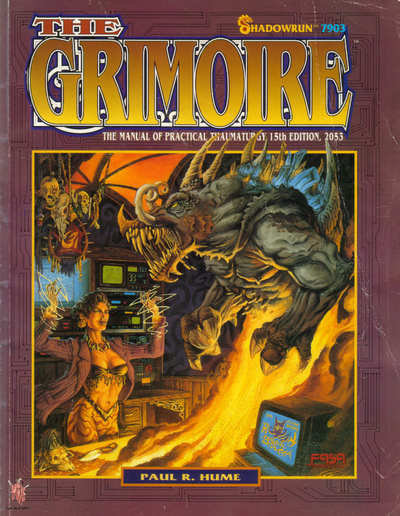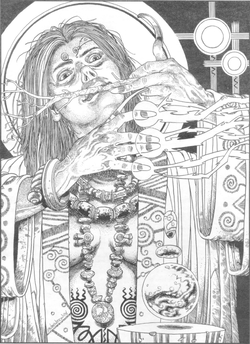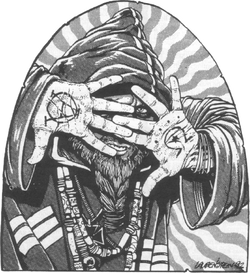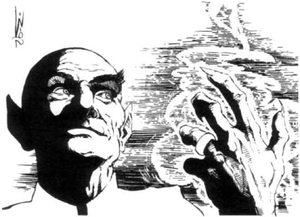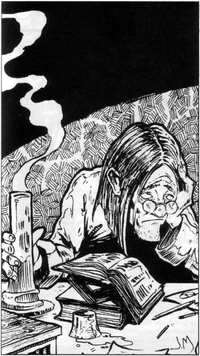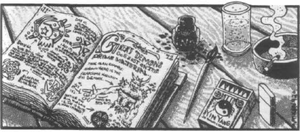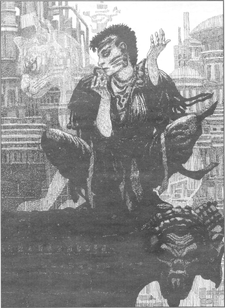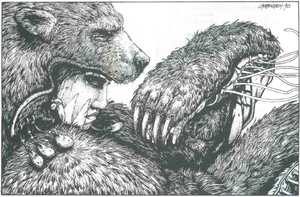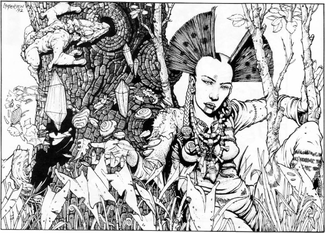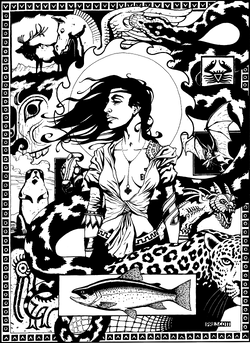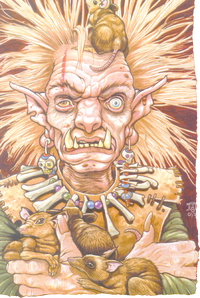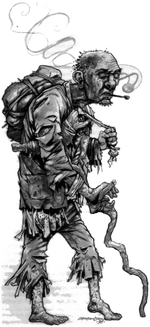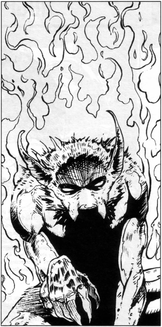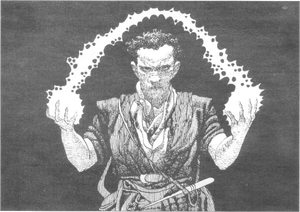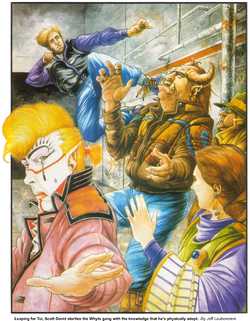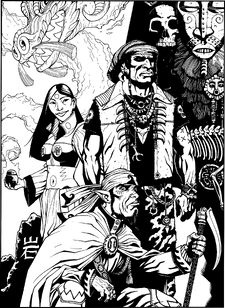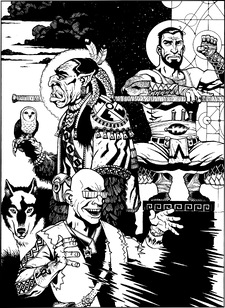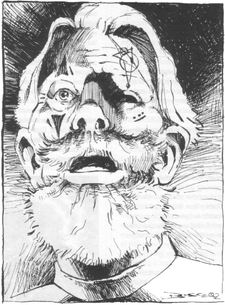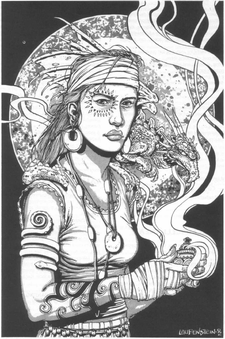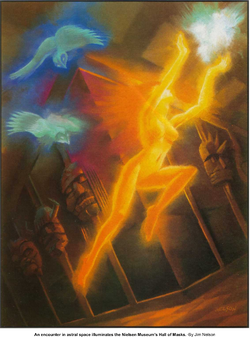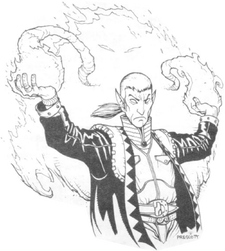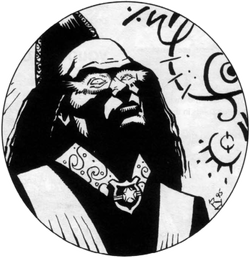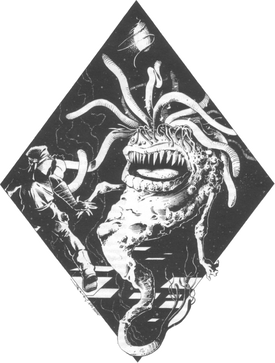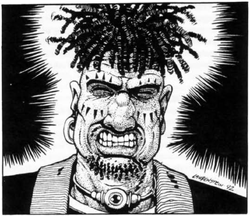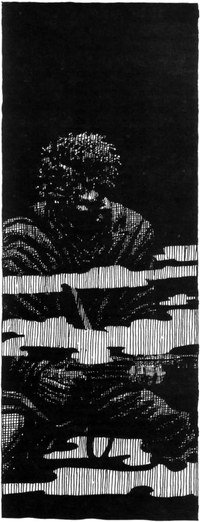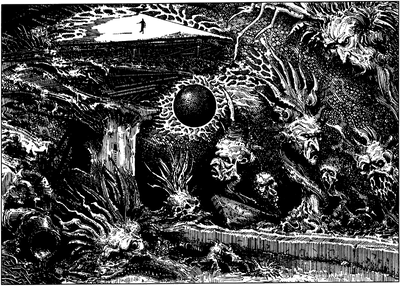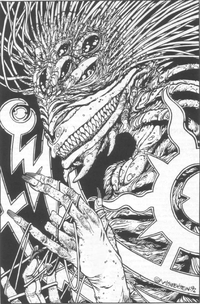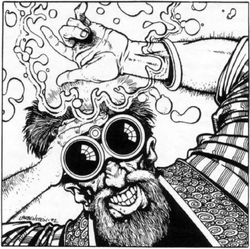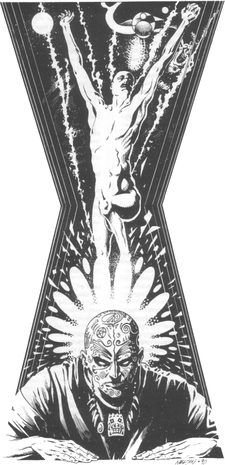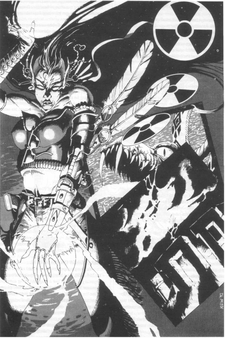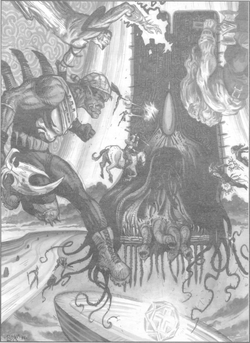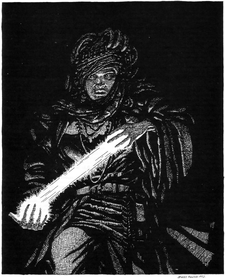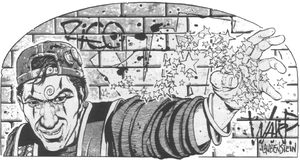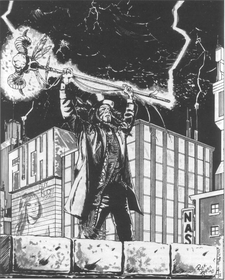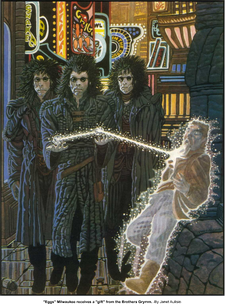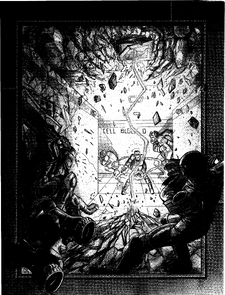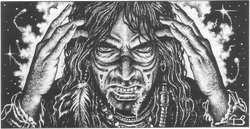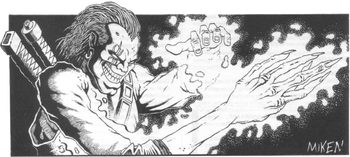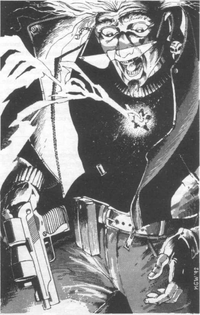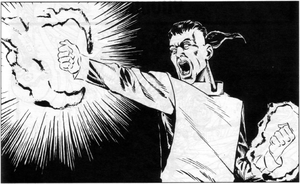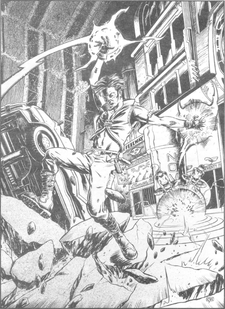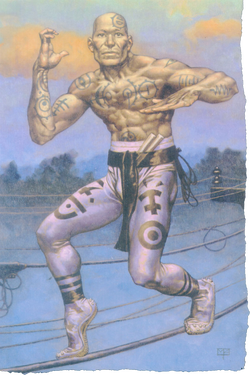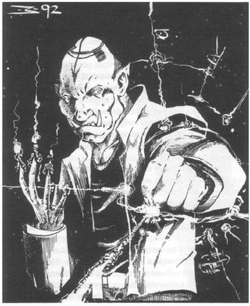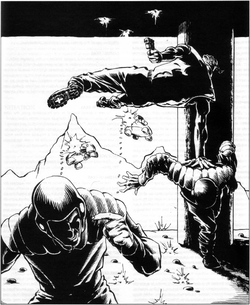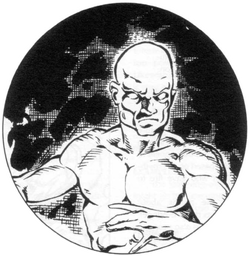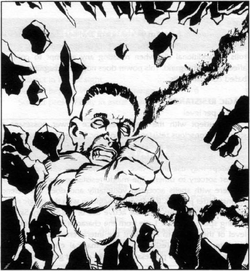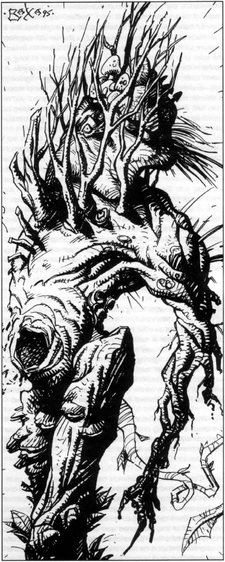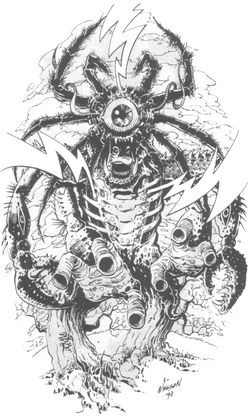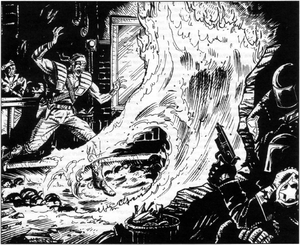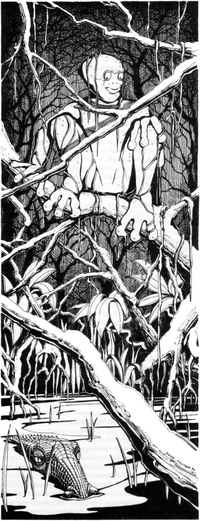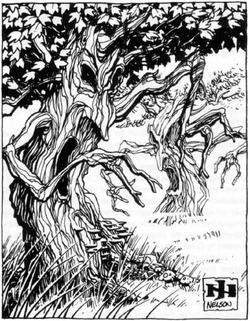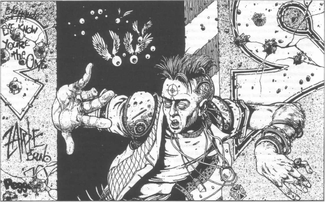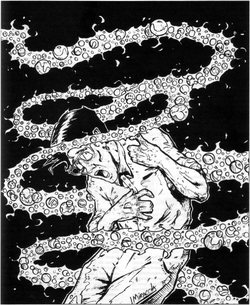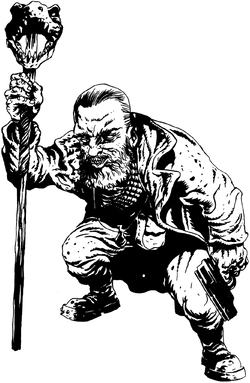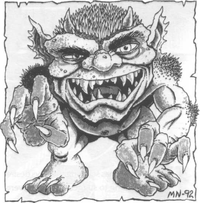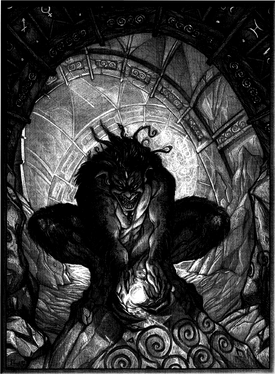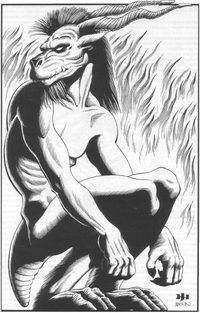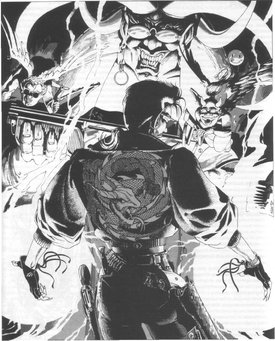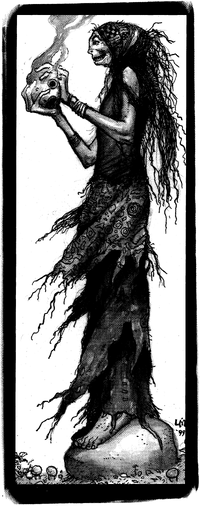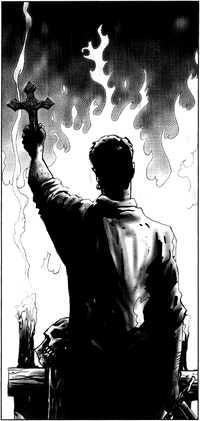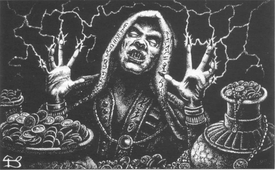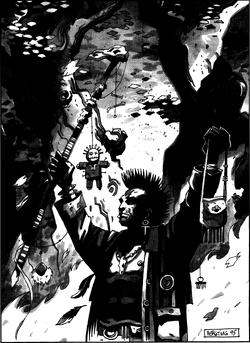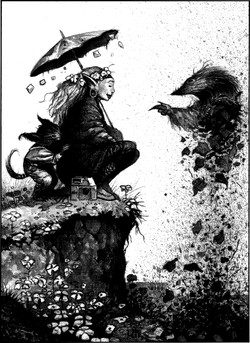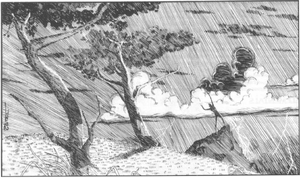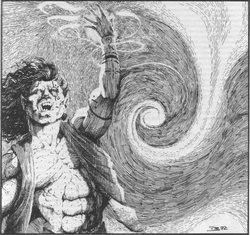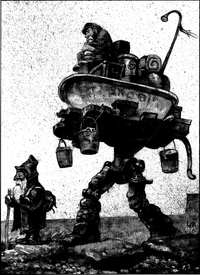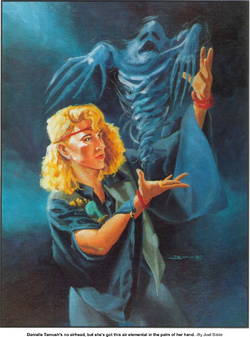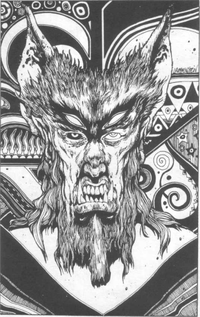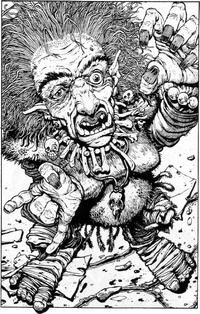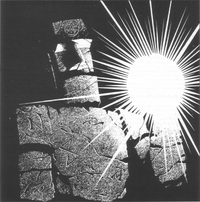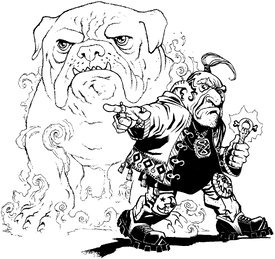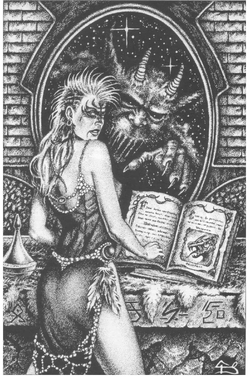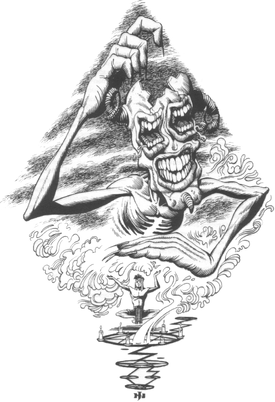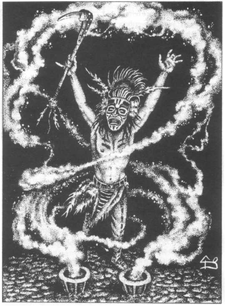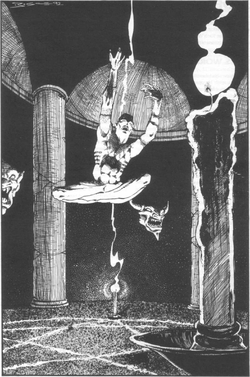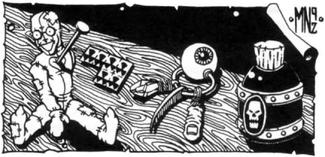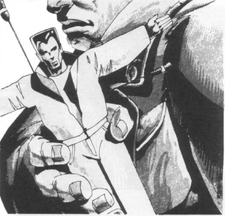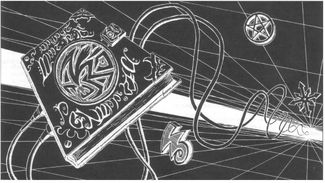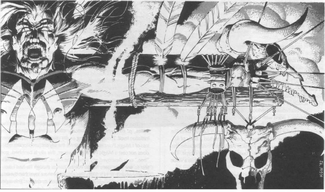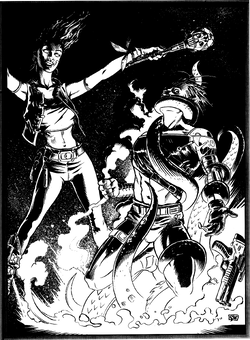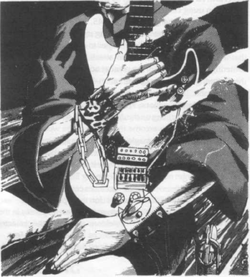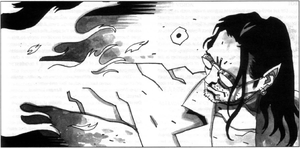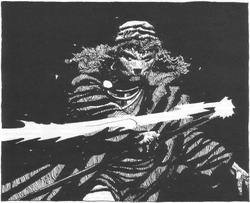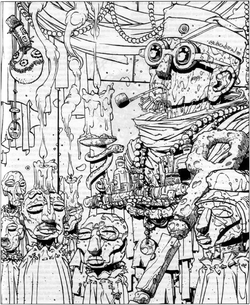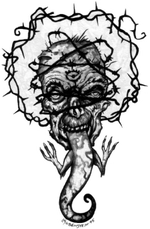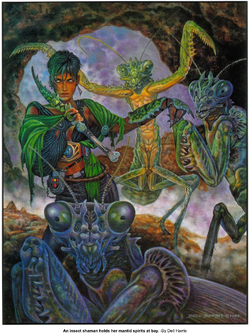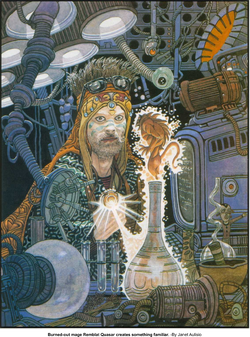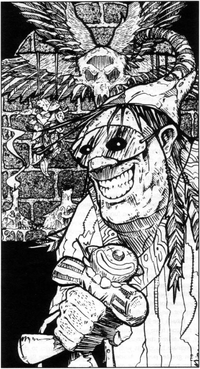Difference between revisions of "Grimoire"
m (→Totems) |
(→Totems) |
||
| Line 107: | Line 107: | ||
{| class="wikitable" | {| class="wikitable" | ||
!colspan=2|'''Animal Totems''' | !colspan=2|'''Animal Totems''' | ||
|- | |||
!rowspan=1| Alpaca | |||
| Alpaca is the earth mother, embodiment of the mountains. Dutiful and patient, she gives of herself while asking little in return. | |||
|- | |||
!rowspan=1| Armadillo | |||
| Protected by his armored shell, Armadillo is slow but strong. While often self-sufficient and focused on his own affairs, Armadillo is a formidable ally, defending those to whom he is close. | |||
|- | |- | ||
!rowspan=1| Badger | !rowspan=1| Badger | ||
| Line 178: | Line 184: | ||
|- | |- | ||
| '''Advantages:''' Advantage on all detection magic and conjuring field and hearth spirits | | '''Advantages:''' Advantage on all detection magic and conjuring field and hearth spirits | ||
|- | |||
!rowspan=1| Dolphin | |||
| Dolphin is the free spirit of the water, dancer on the waves. She is wise, yet playful, and a friend of man, helping people against the threats of the sea. | |||
|- | |- | ||
!rowspan=1| Dove | !rowspan=1| Dove | ||
| Line 220: | Line 229: | ||
!rowspan=1| <span style="color:#00cc00">Horse</span> | !rowspan=1| <span style="color:#00cc00">Horse</span> | ||
| Swift and strong, Horse is the embodiment of freedom. Unpredictable, though not malicious, she roams the land and cannot bear confinement. | | Swift and strong, Horse is the embodiment of freedom. Unpredictable, though not malicious, she roams the land and cannot bear confinement. | ||
|- | |||
!rowspan=1| Hummingbird | |||
| Often misjudged as flighty, in addition to her beauty and quick wit, Hummingbird possesses a deep resilience expressed not in overwhelming strength but endless persistence. | |||
|- | |- | ||
!rowspan=1| Hyena | !rowspan=1| Hyena | ||
Revision as of 02:56, 8 December 2024
Magic Users
With the Awakening in 2011, magic returned to the world. The association between the physical plane—our everyday world—and astral space grew close enough for a talented few to draw power from it.
About one percent of the world's population has the talent to wield magic. A fraction of that percent practice minor magicks, or never get the proper training, or go crazy trying to deal with what they are. By some accounts, there are three to four million fully capable, trained, competent magicians in the Sixth World, though some studies suggest that the percentage is rising with each new generation.
Magical ability usually manifests at or just before puberty, between the ages of ten and twelve years for most humans and metahumans, but as early as eight years for some of the Awakened races. Reported cases of younger children becoming magically active are rare, as are cases of it manifesting in mature adults. Whenever it emerges, the practice of magic requires an individual awakening: if you don't have the talent no amount of effort or study will grant it to you.
While some awakened make do with the minor abilities that can manifest without training—light telekinesis, a hazy sense of the auras that surround living things, or an innate ability to spark a minor flame—dedicated magic users study a tradition, a framework for understanding and wielding magical power based on preexisting mystic heritages, remnants of an early age when magic also flowed freely.
In North America, most awakened study one of three traditions: hermeticism, shamanism, and kineticism.
Mana Drain
Magic users can take mana drain when attempting to use magic or confront magical threats and obstacles. Mana drain represents an attack on the awakened's magical essence. It manifests as damage primarily to the mind or brain: at low levels, symptoms like pounding headaches, intense ringing in the ears, or blurred vision; with moderate mana drain, the magic user might feel as if concussed, fevered, or drugged; at high levels of drain, they might suffer a stroke or cerebral hemorrhaging. Symptoms compound when the awakened take repeated instances of mana drain, progressing to higher levels of damage.
Mechanically, mana drain will generally move a magic user through a progression from Winded to Exhausted to Injured, recovering from each as normal.
Magic Lodges
A magic lodge is a stationary collection of symbols, writings, tools, fetishes, and other mystical materials that helps spellcasters record their lore, expand their talent, and practice magic. It’s a basic tool of magicians across the world, about the size of a room. They need it to learn spells, perform rituals, and craft foci. In a pinch they can use it to protect themselves from magical threats.
Magical lodges aren't particularly portable, taking several days to set up and using several thousand nuyen of materials. These materials can be reused when a lodge is moved.
Each lodge is of a specific tradition—shamans use medicine lodges, hermetic mages use hermetic libraries, and physical adepts use training sanctuaries.
Hermetic Mages
A character who chooses the hermetic tradition becomes a mage. A mage sees the universe as a pattern of abstract forces and energies that can be controlled through complex symbols and formulae of power. Where shamanism is intuitive and improvisational, hermetic magic is more intellectual in its approach, relying on observation, theory, practices, and precise execution. Their magic is based on a complicated set of theories that describe the way astral space contracts and intersects with the physical world. As one might expect, there are as many versions of these theories as there are mages.
Though some magicians may like the country life, stereotypically they are urban types. Mages are scholars and often have elaborate libraries and equipment to assist their research and practice.
Hermeticism Origins
Hermetic magic attracted much interest before the Awakening. Occultists, mystics, ceremonial magicians, surprisingly large numbers from all walks of life were studying the disciplines of the mage at the time of the Awakening, reacting variously with surprise, relief, or even dismay to discover that the magic suddenly worked. As hermetic magic requires complex, intellectual, abstract thinking, many of those who awakened to its practice were corporate employees–scientists, analysts, researchers–hobbyists studying magic in their spare time. As such, the corporations picked up on hermetic magic very early on. To this day the corporations employ wage mages in all capacities, but there are very few shamans. (Try telling Coyote he can only have an hour for lunch.)
Hermetic Libraries
Mages spend a lot of time doing research. They need extensive reference libraries for many activities: learning new spells, designing magical rites, summoning spirits, and so on. The specific contents determine its useful at various tasks, with different mages varyingly specializing their libraries in sorcery, conjuring, magical theory, etc.
Mages can share libraries. Access to the thaumaturgical section of any big university library or corporate reference department lets any number of mages pursue projects at the same time.
A mage may make use of multiple libraries. A hermeticist might maintain a small personal library at home, barely more than a few books on a shelf and a collection of datachips, while making use of a larger, shared research library for more in-depth research.
Shamans
A character who chooses the shamanic tradition becomes a shaman. Shamans receive their power through linking their own inner world of emotion, will, and faith with the external world of nature. This link with nature is personified through a totem, an animal figure that exemplifies the shaman's beliefs and way of life. Totems choose the shaman, waiting for the potential shaman to either heed the call or reject it, such as by choosing an alternate awakened path. Players should also note that a totem is not just a "bear" or even "the bear." The totem is Bear, the archetype for all bears in the world. A totem is not just an animal, but the essence, or true spirit, of that animal.
Shamans are in tune with the ways of nature and life. They are concerned with the maintenance and preservation of their environment, be it the wilds of the Pacific Northwest. the expanse of the Sahara, the majesty of the Amazon rain forests, or the wonderfully complex ecosystem that is a modern city. All is nature, whether it be rocks, streams, trees, and animals, or concrete, steel, neon, and humanity.
Before the awakening, those practicing shamanic traditions would often wear masks to embody their totem. While some still wear them, they are no longer necessary. When a shaman performs magic, the physical traits associated with the totem become more apparent in him. The more powerful the magic, the more noticeable these animal traits become. This is a matter of appearance, not an actual shapechange, and is only visible to the living and spirits. A minor spell might cause an Eagle shaman's features to take on a sharper cast, while with the most powerful spells their features might completely dissolve within the image of a mighty eagle's head.
Shamanism Origins
A shaman's magic comes from the world of nature and the power of emotions. In days past, some "civilized" scholars disparaged shamanism, calling it "primitive" nature worship. When the Awakening came, however, these "backward" primitives knew how to use their new power to pay back the governments and corporations that had oppressed their people for so long. Indeed, shamanism had developed even among some city-dwellers during the boom in occultism at the close of the 20th century. When the magic came back, these "urban shamans" found that the old ways worked well in cities, too.
Medicine Lodges
The medicine lodge is the sacred place of the shaman. It is a little, isolated world where powerful magics can be worked and it is a place for communication with the spirits. Here is where the shaman keeps the special items that are actually and symbolically powerful for him. It is the place where the world of the shaman bridges the worlds of the magical and the mundane.
Shamans generally set up their medicine lodges in or adjacent to the natural habitat of the shaman's totem. A Bear lodge is traditionally set up in the forest, a Turtle lodge along the water, a Bat lodge within a cave. However, some shamans, particularly urban shamans, will create lodges that recreate elements of their spirit's natural environment in order to make their totem spirit more comfortable. An urban Kangaroo shaman may cultivate eucalyptus and palm lily, while an inland Shark shaman would surround themselves with aquariums.
Shamanic lodges may be shared between shamans of the same totem, though the spirit will expect a more elaborate lodge the larger the group of shamans. Many Native American tribes maintain elaborate permanent lodges, be it a hogan, teepee, kiva, cave, or pueblo, for rituals, spiritual communion, and other group activities.
A shaman may make use of more than one medicine lodge. For example, an urban shaman of a non-urban totem may maintain a modest home lodge for simple ritual casting and spirit conjuration, while making use of a more elaborate and extensive nature lodge for learning new spells and other tasks involving deeper communion.
Totems
Shamans are selected by their totem on the basis of a natural affinity. A totem is not a shaman's master, issuing commands. Nor even a teacher, providing direct instruction. Instead, they represent an ideal to strive for, one that rewards devotion to that ideal with power.
While a totem exemplifies an ideal, the humans that idealize it are not expected to perfectly embody that ideal. The totem relationship does not mean that a Cat shaman never has close friends or that a Shark shaman must kill anyone who looks at him sideways. But Cat will not reveal her darkest secrets, or even her telecom code, to every chummer she meets. Neither is Shark going to walk away from a fight just because someone might get hurt.
A shaman that falls out of harmony with their totem, who habitually fails to behave appropriately, does risk damaging their relationship with the totem. A minor discord might result in the shaman no longer benefiting from the unique advantages of the totem, a major discord in the withdrawal of all magical power. This last until the shaman repairs the relationship: the totem is never going to change its perspective.
Shamans are human and may change with time. A shaman that finds themselves truly out of alignment with their totem may, with considerable time and effort, switch to a new totem. This cannot be done on a whim, but allows a shaman to change and evolve. Totems are not human and do not possess such frailties as jealousy. A shaman that respectfully changes totems is likely to run into less strife than one who repeatedly fails an ill-fitting totem they remain with.
The North American shamanic tradition focuses on animal totems, with the many possibilities listed below. Some totemic traditions are particularly common, indicated below in green.
| Animal Totems | |
|---|---|
| Alpaca | Alpaca is the earth mother, embodiment of the mountains. Dutiful and patient, she gives of herself while asking little in return. |
| Armadillo | Protected by his armored shell, Armadillo is slow but strong. While often self-sufficient and focused on his own affairs, Armadillo is a formidable ally, defending those to whom he is close. |
| Badger | Badger is a small creature, but he takes on creatures much larger than himself and wins, enjoying sticking his nose where it doesn't belong. |
| Bat | Bat is well-travelled, rarely staying in one place. A seeker, she sets far-reaching goals and gets restless when not moving. |
| Bear | Bear is powerful in body, but ponderous unless she has to move fast. He seems clumsy and unaware of his surroundings, but he is in harmony with the world and what goes on around him. They are slow in speech but mighty in battle. Bear is a powerful healing totem found in shamanic cultures wherever bears are known, be it North America, central and northern Europe, or Asia. |
| Bear is a healer. Unless a Bear shaman has a good reason to refuse healing to someone who needs it, they cannot do so. | |
| A Bear shaman risks going berserk when wounded. When a Bear shaman is wounded, their willpower is tested to avoid going berserk. A beserk Bear shaman aggressively attacks whatever enemies they can get their hands on, and anyone else who gets in their way, without concern for their own safety. The berserker rage is most easily sated by killing or fully incapacitating an enemy, but otherwise typically burns itself out after a few minutes. | |
| Favored Environment: The forest | |
| Advantages: Advantage on all health magic and conjuring forest spirits | |
| Boar | Strong and aggressive, Boar defends his home ferociously. He rarely attacks without good reason, but once roused he will not yield until he has driven the enemy far from his territory. Neither clever nor subtle, Boar uses violence in combat rather than strategy. If someone invades a Boar shaman's territory, he must attack. This might involve a Boar shaman socially or verbally attacking someone who invades his personal space or physically attacking an intruder in the shaman's home or lodge. |
| Disadvantage to casting illusion magic. Boar shamans must make a willpower test to withdraw from conflict. | |
| Favored Environment: Forest | |
| Advantages: Advantage on all combat magic; plus one service from any spirit summoned for combat purposes | |
| Bull | Others both admire and fear a Bull for his prowess, glad his presence as a defender but wary of his ambition. Proud Bull never forgets a slight or insult, but is generous to those he cares for. |
| Cat | Cat is stealthy, vain, cunning, and sometimes cruel. Cat loves to ferret out secrets, but dislikes sharing them with others, for she is Cat-Who-Walks-Alone. Cat is an urban totem, at home with mankind, either in their company or as a lonely hunter in city streets and alleyways. Cat shamans are solitary types, committed to no one but themselves. |
| Cat will toy with an opponent in battle, even when the situation is desperate. He will threaten, sneer, and hiss, displaying his dominance. She will also use showy magic, flashy physical combat, or other irrelevancies in the process of the kill. Cat shamans must overcome the influence of their totem to quickly finish off an enemy,.. unless the shaman has been hurt, in which case all this playing around stops. | |
| Cat shamans face difficulty in allowing themselves to be dirty or unkempt, feeling a basic need to be groomed. | |
| Favored Environment: The periphery of man | |
| Advantages: Advantage on all illusion magic and conjuring city spirits | |
| Cheetah | A swift-moving warrior, Cheetah cares little for subtlety, preferring to quickly traverse the most direct route to any goal. |
| Cobra | Cobra is stealthy and dangerous, hypnotizing her prey to bring them close. She is slow to make choices, but her moves are deliberate and without compromise. |
| Coyote | Coyote is the Great Trickster, unpredictably bold one moment, cowardly the next. He can be a friend or a cruel joker who leads one into danger. Coyote is also the great magician. A Coyote shaman is too independent to be bound by anything except her word. Like Grandfather Coyote of the legends, he is intensely curious. She is also typically greedy and fond of taking risks just for fun. |
| Favored Environment: Anywhere on land | |
| Advantages and Disadvantages: None. Coyote shamans would never permit themselves to be limited by such concepts. They are beyond rules and live by their own wits. | |
| Cougar | Cougar prefers to stalk her prey at night, choosing guile over direct confrontation. A loner, she usually lodges far from civilization. |
| Crab | With a well-earned stereotype as a grumpy curmudgeon, the hermit of the sea's sense of independence is earned by carrying his home on his back, and his many complaints never cause him to waver in his resolve. |
| Crocodile | Crocodile is a relentless pursuer of prey and a savage in combat. With no fixed home, he wanders far. |
| Dog | Dog is loyal to friends and family. He fights furiously to defend his home and holdings, but is not generally aggressive outside his own territory. Dog loves people, and will defend them pitilessly from dangerous spirits or evil magic. Once a Dog shaman gives her loyalty or love, she will remain loyal even if the person she loves is unworthy. A Dog shaman will try to protect humanity from evil magicians at any cost. |
| Dog is single-minded, to the point of stubbornness. A Dog shaman must battle against her totem to change her plans or tactics. | |
| Favored Environment: Anywhere man lives | |
| Advantages: Advantage on all detection magic and conjuring field and hearth spirits | |
| Dolphin | Dolphin is the free spirit of the water, dancer on the waves. She is wise, yet playful, and a friend of man, helping people against the threats of the sea. |
| Dove | A peaceful messenger and mediator, Dove helps others to the point of martyring herself. |
| Eagle | The highest-flying bird in the sky, Eagle is proud and solitary, surveying everything that happens on the Earth over which it flies. |
| Elk | Elk is a gentle and wise protector. Majestic in opposition, in times of peace he may be found wandering in contemplation. |
| Fish | All glimmering scales and swift fins, Fish is quick and clever, evading the fisherman's hook and the predator's jaws. In the east he is Carp, while in the west he is often seen as wise Salmon, but regardless of the mask he wears, Fish is wise. Fish shamans love secrets but loathe giving them away. Only sharing his insight with those swift enough to catch him, they always bargain for the best deal when parting with information. |
| Disadvantage to combat magic | |
| Favored Environment: On or near water | |
| Advantages: Advantage on all detection magic and conjuring spirits of the water | |
| Fox | The essence of sly wit and cunning, Fox is the master thief and trickster. While caring little for battle, Fox bites for the kill when forced into it. |
| Frog | Frog is always concerned about the well-being of others. He has a great affinity for water, be it in a river, lake, or even rainfall. Frog is a great fan of relaxation for its own sake, but she is not lazy about it the way Gator is. "Helpful" is about the best single word there is to characterize Frog's behavior; their shamans are always helping others without as much thought for themselves. |
| Their urge to help others often results in a Frog shaman being used by others. Frog is also a very vocal totem—she tends to blurt things out, or talk to himself at times when silence is important. Frog shamans are often overweight, and most are slower than average. | |
| Favored Environment: Ponds, swamps, marshes, and rainforests | |
| Advantages: Advantage on all health magic and conjuring spirits of water | |
| Gator | A great eater and greater fighter, Gator is swift to act when action is called for, but lethargic, even torpid, the rest of the time. |
| Gecko | Fast moving and always on the lookout, Gecko is impossible to pin down and always manages to get into places he shouldn't go. |
| Goose | Goose is proud and territorial, known to become loud and boisterous when threatened. She is acquainted with the high places as well as the low. |
| Horse | Swift and strong, Horse is the embodiment of freedom. Unpredictable, though not malicious, she roams the land and cannot bear confinement. |
| Hummingbird | Often misjudged as flighty, in addition to her beauty and quick wit, Hummingbird possesses a deep resilience expressed not in overwhelming strength but endless persistence. |
| Hyena | Hyena is aggressive, capricious, and cunning, serving her own needs above all else. She fanatically defends her position, fighting lions for her share of the kill. |
| Jackal | Like Rat, Jackal is a stealthy thief too selfish to share. A reluctant warrior who would rather run than fight. Unlike Rat, Jackal is mischievous and play, preferring to act unconventionally. |
| Jaguar | Jaguar is a stalker who uses her skills and predatory instinct to track down her goals and finish them off with ruthless efficiency. Jaguar shamanes rarely specialize, preferring to acquire a moderate level of competence in many skills rather than mastery of a few. |
| Disadvantage to casting health magic | |
| Favored Environment: Jungle | |
| Advantages: Advantage on all detection magic and conjuring forest spirits | |
| Leopard | Leopard possesses great strength, stamina, and speed. Aggressive and quick to anger, Leopard is reclusive and secretive, watchful for those who might corner it. |
| Lion | Lion prefer to hold his strength in reserve, whether allowing others to perform tasks for him or waiting to spring an ambush. Powerful when roused, he leaps to action when his kin or family is threatened. |
| Lizard | Lizard is placid and slow to anger, preferring to bask in whatever the situation offers. He acts swiftly, however, when an opportunity arises. |
| Monkey | Monkey is clever and playful and likes people because they are funny. He is a foe of evil and enjoys taunting and frustrating the plans of those who would harm him or his friends. Monkey likes to taunt opponents, using magic to trick them. Monkey is very good at climbing and making her way through the most difficult places. |
| Disadvantage to casting combat magic | |
| Favored Environment: Forest | |
| Advantages: Advantage on all manipulation magic and conjuring spirits of man | |
| Otter | Otter is loyal and mischievous. She knows her territory well, observing everything with a careful eye. Otter shamans are always full of nervous energy, which they channel into their playful sense of humor. |
| Owl | A wise and silent watcher, Owl rarely speaks, but sees much. She is friendly to her companions, but terrible to her enemies, so long as she finds them by night. |
| Parrot | Parrot is a colorful, wise-cracking showoff. Her plumage is the brightest, her voice the loudest, and her magic the showiest. They must be the center of attention and drop everything to get the spotlight. |
| Parrot's magic exists to bring applause. Cannot gain Advantage when magic use isn't impressive to a witness. | |
| Favored Environment: Jungle | |
| Advantages: Advantage on all illusion magic and conjuring jungle/forest spirits | |
| Polecast | Slinky and clever, playful but rough, Polecat prefers to tackle problems that she can sink her teeth into. |
| Prairie Dog | While Prairie Dog is playful, fun-loving, and friendly, he is not naive and keeps his eye out for danger, with the help of the network of family and friends he finds himself driven to build. |
| Python | Slow and ponderous, neither clever nor swift, Python is dedicated to crushing strength, merciless once he gains the upper hand. |
| Raccoon | Raccoon is a clever bandit who can break open any trap to remove the bait. He can also escape any danger, for his paws are like cunning hands. Raccoon fights when she must, but prefers strategy and trickery. |
| A Raccoon shaman is a loner. Like Coyote, her intense curiosity makes her ignore danger in any quest for information. Raccoon can be greedy (this is a thief totem), but Raccoon shamans will steal only the very best, for petty thefts and violent robberies are beneath their dignity. Raccoon shamans tend to avoid conflict, and face disadvantage with combat magic. | |
| Favored Environment: Anywhere but the desert | |
| Advantages: Advantage on all manipulation magic and conjuring city spirits | |
| Rat | Rat is a stealthy thief who is too selfish to share anything, even with his companions. She is also a reluctant warrior who would rather run than fight. Where mankind goes, there also goes Rat, for who else's bounty can sustain them? |
| Rat shamans are usually dirty and unkempt. Rat is a coward, but when he must fight, he fights to kil. Rat dislikes working out in the open, for a muttered spell from the shadows (or a silenced pistol from a doorway) is more her style. As such, they face difficulty using combat magic in the open. | |
| Favored Environment: Among the refuse of man | |
| Advantages: Advantage on all detection and illusion magic and conjuring all Spirits of Man | |
| Raven | Like Coyote, Raven is a trickster, clever and devious. Raven is also the transformer, responsible for changes. He is a living contradiction, greedy and generous by turns. |
| Raven shamans are either overweight or else rail-thin. In either case, they are gluttonous and always hungry, finding it next to impossible to refuse an offer of food. Raven dislikes fighting, preferring to let others handle that part of life. Shamans face difficulty with combat magic and all casting or conjuring when not under the open sky. | |
| Favored Environment: Anywhere under open sky | |
| Advantages: Advantage on all manipulation magic and conjuring wind spirits | |
| Scorpion | The dancer of death, Scorpion fears no foe. He strikes swiftly and without mercy, deploying every advantage he can avail himself of. Invisible in her home, she strikes enemies swiftly and without mercy. |
| Disadvantage to all magic during the day. Scorpion shamans become irritable and depressed when away from their home for long. | |
| Favored Environment: Desert | |
| Advantages: Advantage on all combat and illusion magic; Advantage procuring, using, and resisting poisons | |
| Shark | Shark is a cold and relentless hunter. When Shark strikes, he does so without mercy, driven into a frenzy by the blood of his prey. Shark shamans tend to be wanderers, always on the move. They are fierce and deadly warriors. A Shark shaman believes the only good enemy is a dead enemy. If challenged, they do not waste time with threats or boasts, but strike to kill. |
| A Shark shaman risks going berserk when wounded or killing an opponent. They must make a willpower check. On a Twist, they aggressively attack whatever enemies they can get their hands on, and anyone else who gets in their way, without concern for their own safety. The berserker rage is most easily sated by killing or fully incapacitating an enemy, but otherwise typically burns itself out after a few minutes. A berserk Shark shaman may, instead of attacking a living target, continue to attack the body of their last victim, if the player chooses. | |
| Favored Environment: On or by the sea | |
| Advantages: Advantage on all combat and detection magic and conjuring sea spirits | |
| Snake | Shake is a wise healer who dwells in many places and knows many secrets. She's a good counselor, but exacts a price for her advice. |
| Spider | Spider is the great weaver, the builder of all things. Her web links everything, showing what was and what will be. She is eternal change, the cycle of life and death, the center of all things. Their smile is both benevolent and fearsome, according to the time and their mood. He wants patiently, for in time, all things come to him. |
| Disadvantage to casting magic in the open, away from immediate shelter | |
| Favored Environment: The quiet, dark places into which others seldom look | |
| Advantages: Advantage on all illusion magic and conjuring all spirits when setting a trap | |
| Stag | Noble and swift, Stag is prideful in his dignity. Often detached from the physical, he does not soon forget slights. |
| Turtle | Turtle values survival, seeing it as a privilege to be earned. Preferring to hide from danger, Turtle shamans rarely devote themselves to other, preferring to withdraw than face conflict. |
| Whale | Part of a vast ocean community, Whale holds tradition dear. Contemplative and slow to anger, Whale gives her oath cautiously, as she cannot abide break it. |
| Wolf | Wolf is the hunter and warrior. He is brother to all his pack, and fiercely loyal to his mate and cubs. As the ancient saying goes, Wolf wins every fight but the last, and in that one, she dies. |
| A Wolf shaman is loyal to her friends and family until death. Nothing can make him betray those bonds. Nor will he ever show cowardice. When a Wolf shaman extends her protection to another or otherwise accepts a responsibility, nothing can make him betray that bond. Wolf can, however, go berserk as Bear does. | |
| Favored Environment: The forest, prairie, and mountain | |
| Advantages: Advantage on all detection and combat magic and conjuring forest or prairie spirits (one of the two, depending on the shaman) | |
While many shamans follow animal totems, some follow various other types. Nature totems include the moon and sun, mountains, sea, and rivers, and the wind and the oak. Mythic totems range from the patient Gargoyle to the Phoenix's embrace of the cycle of life and death. Other shaman follow idols like Bacchus, the idol of motion and revelry, or the Fire-Bringer, a Promethean figure whose good intentions can lead him to ruin. The Loa embraced within the African diasporic traditions—whether Haitian Vodou, Dominican Vudú, or Louisiana Voodoo–include Agwe, the Loa of the Sea, and Legba, the Old Man of the Crossroads.
Physical Adepts
A character who walks the path of physical kinetic discipline becomes a physical adept. Rather than focusing outwards, a physical adept directs their awakening inwards, focusing on enhancing their own abilities.
While many physical adepts draw from religious traditions that focus on spiritual concepts like inner harmony or self-discipline, others may conceptualize their focus on self-improvement differently. The essential connection between all physical adepts is the inward focus of their development.
Kineticism Origins
A physical adept is dedicated to improving the body and its abilities. Powers attributed to legendary martial artists, warriors of shamanic peoples, berserkers, and the like, suggest that such adepts may have existed before the Awakening. The first publicly documented physical adept in modern times was Francis Daniels, an engineering Ph.D. and fourth dan ki-aikido black belt. Much of the current understanding of the abilities of the physical adept are due to research Daniels conducted before his untimely death in the riots attending the collapse of the U.S. government in the Washington D.C. metroplex in 2030.
Training Sanctuaries
Training sanctuaries are where physical adepts can practice their disciplines, meditate, and enhance their skills. These sanctuaries vary depending on the adept's focus, whether it be martial arts, acrobatics, or other physical pursuits. While an adept my use a traditional gym or dojo to practice portions of their art, they also need a space to expand their consciousness. While this may include meditation areas, sensory deprivation tanks, or zen gardens, some element of it will specifically aid them in channeling this expanded consciousness physically.
Just as other magic users might make use of multiple magical lodges, some practitioners split these functions into different locations. It's not unusual for a physical adept to have a private sanctuary for personal development and a group sanctuary for training and sparring with others.
Alternate Traditions
The above traditions are the dominant ones in North America. Other cultures may study other traditions, though their functional elements often have significant similarities to the North American traditions in practice due to the fundamental underlying natures of magic and human psychology.
Astral Space
Astral space is a parallel dimension that coexists with the physical world. It is both the source of magical energy and the medium through which it travels. Though astral and physical space are vastly different, the two share the common dimension of time. Astral space operates according to its own laws: the laws of physics do not apply, except insofar as some elements of astral space reflect what happens in physical space.
Assensing
Astral space is not perceived through a physical sense. It is instead assensed by those who have access to it. The perception of magical energy and astral form is known as assensing, whether performed by visitors to astral space, such as awakened magicians, or its native denizens, like spirits.
Physical Entities
Everything that exists on physical Earth also has an astral counterpart, though most of it is little more than fog and shadow to an astral denizen. Beings in astral space can see physical objects and assense magical energy given off by the astral forms of all living things.
Inanimate Objects
The shape of inanimate objects is visible in astral space, though not qualities such as color or brightness. They appear as a grey fog of themselves, with much of the fine detail erased.
These objects possess no corporeal astral form of their own. As such, astral beings can freely pass through the astral position corresponding to the object's physical location. In astral space, one cannot see or assense through a wall, but it is a simple matter to walk right through it.
Transparent objects retain that quality. Being both incorporeal and invisible in astral space, such objects might easily be mistaken for empty space to those not performing a close examination.
Living Things
Non-magical living things have a dormant astral form, an aura that is visible and corporeal in astral space, but insufficiently strong to allow overt action on astral entities.
Rather than a vague fog, as with inanimate objects, living things have well-defined shapes. They are not grey and colorless, but nor do they appear quite as they do in physical space. Rather they are colored with the energy of their life, with hue and brightness representing their vitality, health, and the character and intensity of their thoughts and emotions. One cannot read a subject's thoughts from astral space, but intense hate, fear, or joy are all apparent in a subject's aura to a trained observer, as well as the effects of various drugs.
While not immediately obvious, magical attributes—if possessed—are among the easiest attributes of a living things to detect. A physical adept that is not astrally perceiving or using any other magical ability is no more astrally-present than any other living thing, but their aura may be assensed to determine their magical aptitude and broad elements of their magical ability.
Things reveal their true forms and natures when viewed in astral space. Auras do not lie, and they are unique. Disguises, whether physical or magical, simply do not work astrally. A shape-changed elf retains his original aura, regardless of the final form.
It is not possible to pass through things that are alive, no matter at what level, in astral space. Vegetation, for example, blocks movement just as it does in the physical world, except that an astral traveller cannot brush such an obstacle aside. As such, even a modestly dense concentration of life is capable of barring astral passage. Note that this does not generally apply to microorganisms: a bacterium suspended on a droplet of water released in a sneeze does not impair an astral traveller.
Earth
The Earth itself is a living thing in magical terms and thus corporeal in astral space.
Artificial Intelligences
A true artificial intelligence is alive and possesses a corporeal astral form. This fact was crucial in the determination of AI personhood and is the definitive test of whether a smart system is a virtual intelligence or a true AI and therefore in possession of rights under the laws of most countries.
Magical Entities
Magically-active physical things—dual-natured creatures, magicians using astral perception, active foci—are visible, corporeal, and capable of action and being acted upon in astral space. It is immediately obvious to an assenser if something is a magical entity with full astral presence. These sorts of magical entities typically appear as an astral manifestation of their physical appearance enveloped in an aura reflecting their physical nature, that may be analyzed with assensing, whether a living thing or inanimate object.
Hermetic Elements
The hermetic elements of water, air, and fire are tangible in astral space, but astral beings can pass through these elements because of their low density. Water and fire do no harm to the astral traveler, but do reduce the range of assensing.
Abstract Information
Astral space pulses with the primal energies of life. Artificial symbols, objects of the intellect, are not directly perceptible in astral space. However, the deeper meanings and emotions tied to them may be observed with assensing.
Someone examining the astral counterpart of a book would find that they could not read the words themselves, but that they could vividly sense the emotions of each passage. Books of poetry, for example, are rewarding, even overwhelming, when assensed astrally, while technical manuals are virtually blank.
Similarly, scanning a computer screen in astral space would not reveal the informational content, but would impart the emotional context of the file—that is, whether it was public or secret data; legal or illegal; personal, technical, or business-oriented.
Neither street signs nor even maps can be read from astral space, so an astral traveler had better know where they are going before they set out.
Visibility
Lit by radiant life energy, astral space is usually bright no matter what the time of day on the physical plane. However, certain places that are devoid or lacking in living material (within a bare concrete room, for example) may actually be dim or dark. As such, inanimate objects—which are only visible because of reflected astral illumination—may be difficult to make out in such places.
This, of course, is only a problem to those assensers that lack physical bodies, like unmanifested spirits or the astrally projecting, as those that possess them produce their own living astral illumination.
Astral Entities
In additional to physical entities, there are entities that exist only in astral space, such as unmanifested spirits, in-transit spells, and astrally-projecting magic users (which, while they do have a physical body, are separated from it).
Such entities have a corporeal astral presence as with magical physical entities. Living astral entities like spirits and projecting magicians may be assensed as living things.
Astral Barriers
Astral-specific barriers may be constructed in astral space. Magic circles and the boundaries of medicine lodges are inherently astral barriers, but they may also be independently constructed. Astral barriers block astral perception, astral passage, and the passage of astral phenomenon like in-transit spells. They are obviously perceptible as floating planes of magical force.
Entities not active in astral space are not affected by astral barriers. However, while the physical form of a dual-natured entity cannot be directly affected by the barrier, its astral form can be. As such, a dual-natured critter, astrally-perceiving magic user, active foci, or other dual-natured entity may be badly damaged or even killed or destroyed by attempting to cross an astral barrier without first disrupting it.
Spells
When viewed from astral space, the casting of a spell reveals the formation of a living shape around the caster, which charges toward the target at high speed when released. Reaching the target, it vanishes, exiting into real space, where it releases its power. Even manipulation spells that traverse the distance in normal space behave this way.
As independent entities once cast, spells may be manipulated by astrally-present entities. However, they travel extraordinarily quickly, making attempts to affect them very difficult.
Astral Signatures
Magical skills and abilities produce an astral signature on anything affected by them, which is detectable using assensing.
An astral signature carries the magical “fingerprint” of the awakened creature who created it. Barring the use of an initiation like flexible signature, the impression left by an awakened person or creature contains detectable elements specific to them that can be matched both across their other uses of magical abilities and to their aura.
An astral signature also contains information about the skill or ability that created it. The type of skill or ability used to create it is most obvious: whether it is an adept ability, spell, spirit ability, or the innate power of an awakened animal. A closer examination can reveal the category of effect used (e.g., a detection spell, an illusory adept ability) and a full analysis the specific spell or ability.
Spells that directly affect something in the world—a fireball hitting a wall—are mostly observed at the point of their immediate effect: the fireball's astral signature will occupy the area in astral space corresponding to the scorching of the wall in physical space.
Spells that act on people linger both on those people and what those people interact with in the environment. An invisible man with magically-hushed steps carries the fingerprint of his activity on himself while also planting it on his surroundings, whether as a series of traces on the things he touches, or simply a floating presence impressed on the background of astral space. Abilities used on objects—a car subject to a disguise spell, for instance—leave traces in a similar way.
By default, the signature of a magical ability lasts for four hours, counting from when the ability stops being used or moves out of the area. However, this may be modified:
- When an ability is sustained for only a minute or two, add two hours to its signature.
- When an ability is sustained for most of a scene, add four hours.
- When an ability is sustained for over an hour, add six hours.
- For each ability past the first used simultaneously by a particular magic user, add four hours to the resulting astral signature from those abilities.
Magical sanctuaries, magic circles, and bound foci always carry an astral signature of their owner.
Influencing the Physical
The two realms are separated by an interface that can only be crossed under specific circumstances and criteria. This means mundane entities like inanimate objects and living things are mostly protected from direct effects from astral space. Magical physical entities and astral entities that have an active presence on astral space, however, are left exposed to astrally-projecting magicians and exclusively-astral spirits and creatures.
Grounding
A spell or other magic ability cannot normally be cast from astral to mundane space.
However, dual-natured entities (manifested spirits, astrally-perceiving magic users, active foci, certain awakened critters) create a pathway between the two realms. Through this channel an astral entity can target a magical ability at the dual-natured entity's physical form. Because the ability is affecting the physical materials of the target, the ability must be of a physical type (e.g., not a mana spell).
Where the physically-effecting magical ability is area-effecting, the dual-natured entity may be used as the locus of the area effect, so long as the caster can see the various targets in astral space (which does not require the targets to be active on the astral plane). Due to the nature of how this effect works, manipulation spells cannot be used in this manner.
A dual-natured entity, whether alive or inanimate, reflexively opposes being used as a bridge. An entity that successfully defends against the attempt ignores it and the ability may not be channeled through it to affect others. A spell that beats the ability's resistance may affect the entity, its wielder (for foci), and those in the area, as appropriate.
Background Count
In a magical context, the background count refers to the presence of powerful influences that can distort the etheric medium, making the use of magical abilities more difficult.
A low-level background count is easily created and quickly fades away. The repeated use of magic in a particular location in a short period of time, particularly by people from different traditions, can induce a low count. Alternatively, it can be created by the performance of a violent crime where someone is injured. These counts fade within an hour or two. A low-level background count applies Disadvantage to navigation when astrally projecting: the projector is more likely to get turned around, fail to identify their current location, and keep track of elements of the current location not present in astral space.
A moderate background count requires more sustained activity to create and will tend to persist for a much longer time. It occurs in places where living things are rigidly constrained or suffering ongoing misery: a maximum-security prison, the terminal ward in a hospital, most large factories, slaughterhouses, and the like. It occurs in places where a large group of people are expressing powerful emotions: a rock concert, an Urban Brawl game, a riot, or a revival meeting. A moderate background count can be created for decades at major battlefields or other places of mass suffering, such as slashed-and-burned forest areas. A moderate background count applies Disadvantage to all astral activity, including assensing and astral navigation.
A heavy background count is the most hostile form of astral terrain. It occurs in heavily polluted areas such as slag heaps, strip mines, abandoned factories, burned-out residential areas, polluted rivers, toxic-waste dumps, and radioactive waste storage sites. It occurs any place where a major battle is occurring. It also occurs in any place that has been the site of intensive positive emotions, religious worship, or magic for an extended period: most cathedrals, monasteries, lamaseries, shrines, Arlington Cemetery, and Stonehenge. Other examples are scenes of sudden, mass death such as transportation disasters and terrorist massacres. Near-permanent heavy background counts exist at Hiroshima and Nagasaki and at Auschwitz and areas of Cambodia. A heavy background count makes detailed asssensing almost impossible, astral navigation highly difficult, and applies Disadvantage to all spellcasting, adept abilities, and other magical abilities.
However, background count does not remain constant. Magical impulses ebb and flow in irregular rhythms. As such, it can be difficult to judge in advance what the background count will be of any particular location. A tranquil forest might experience an unexpected spike in the background count, while a riot might experience a sudden period of astral clarity.
Further, the background count will not negatively affect, and may even positively affect, magic that is in alignment with it. For instance, holy places may help in the performance of charitable healing. Toxic places do not interfere with the actions of toxic shamans. A background count created by one mass slaughter would not prevent magic used in the performance of another.
Metaplanes
There are realms beyond that nearby etheric plane that lesser practitioners mistake as the extent of astral space. There are pockets of astral convolution known only to their inhabitants and those higher initiates who alone among humanity have the power to reach them. There are the metaplanes, the higher depths of astral space in which entire worlds reside.
Even the uninitiated have typically heard of the eight most common metaplanes. Four correspond to the hermetic elements: fire, water, air, and earth. Four correspond to the major shamanic domains: the realms of man, the waters, the sky, and the land. Confoundingly, while hermetic mages can only summon elementals from the former and shamans summon spirits from the latter, initiates of either tradition can travel to any metaplane regardless of the association of its denizens.
Additional metaplanes exist, but information about them is coarsely spread. The paths to the domains of Insect Spirits, Horrors, and other deep denizens are rarely shared, whether hoarded for the power granted to those that traverse them or guarded against the dangers posed by those who find themselves enthralled to the masters of the far reaches.
Accessing Astral Space
Even though all magical power is drawn from astral space, not every magic user can actually perceive astral space. It takes effort, time, and training, and even then not every magic user possesses the talent.
Astral Perception
Astral perception refers to the ability of some magic users to perceive astral space while remaining incarnate in their physical body. Any tradition of magic user can learn to perceive astral space given proper talent and training. While it must be purposefully activated, it takes only a moment to switch from normal senses to astral senses and back again.
When perceiving astrally, the magician's senses are focused on the astral plane. Purely physical things are visible only by their astral echo, making interaction with the physical world very difficult. Mechanically, an astrally-perceiving magician attempting a task based solely in the physical world faces Disadvantage in doing so at best.
Because the character is only perceiving astrally, a magician that is astrally perceiving is still limited by the constraints of their body. The character can touch and be touched by other astrally active things, but they cannot reach through a wall to touch an astral object because the physical arm cannot penetrate the physical wall even though the astral arm has no such restrictions.
See the section on assensing physical entities for how various physical things appear in astral space and the related section on astral entities.
Astral Projection
The next step beyond astral perception is actual projection, in which the magician's aura separates from their body and is able to move about freely and independently for some time. Only spellcasters (hermetic mages and shamans) may learn to astrally project.
Magicians enter astral projection by sinking into a trance. While in this trance, the magician's body is dead to the world: their pulse and respiration are almost nil, and their senses are turned off. Until the magic user's aura returns, the physical body is comatose.
Ideally a projectionist is lying in a nice comfortable bed or recliner, but plenty have made do propped up in the back of a car or slumped over a desk or table. An uncomfortable projection doesn't interfere with the astral travel itself, but it might leave the magician with stiff joints or the like upon their return.
– Marauder
While no traveller can perceive their body while afar, some peoples possess traditions for maintaining more than a helpless recline. The Ute can stay upright on a horse while projecting, a Maasai mystic can walk with a group while away, and I've heard stories of projecting Sioux riding along within a pack of motorcycles.
– Naked Zulu
Nonsense, obviously.
– Comrade Data
A magician's physical attributes are irrelevant in astral space. Strength, quickness, and resilience are all derived from their mental abilities. A paralyzed caster has full function in astral space, and neither the blind nor deaf face any difficulty in assensing. Cyberware and other modifications that boost physical performance provide no benefit.
Without initiation, astrally-projecting magic users may only travel to the near astral plane, the mirror of the physical plane. While the uninitiated may be intellectually aware of the metaplanes, travel to them requires additional mystical awareness.
Astral Form
The projecting magician's astral form appears as an idealized self-image. While for many magic users this resembles a modestly flattering version of what they see in the mirror, those who spend considerable time in astral space can develop more evolved appearances. The idealized self-image of a devout ork shaman or a coldly murderous corporate hit mage can be a pretty scary assensement.
Astral images of the magician's fetishes and magical items accompany the journey. Non-magical gear stays with the comatose body in the physical world. Simply by willing it to be so, the astral magician can form any garments or ornaments desired, but such things have no magical or armor value. It is just razzle-dazzle.
Astral Movement
Barring astral obstacles, astrally projecting magicians can move with freedom in three dimensions. However, projectionists are advised not to attempt to leave the atmosphere (80 kilometers). Magicians who have tried to break this barrier have usually died or gone mad upon encountering the astral void, and the memories of those who survived the journey have been badly scrambled by some kind of profound mental trauma.
Astral travel at normal speed requires little effort from the magician. With a thought, the traveller can drift slowly through a room to examine it, fly above a city street scanning the astral environment, or chase down a speeding car on the freeway.
Much faster than that involves more meaningful effort. A skilled projectionist racing from New York to Seattle might do so in only half an hour, but might need a moment to mentally recover when they reach their destination. When travelling at such speeds the magician's surroundings are a blur. The character knows where he is and can dodge astral obstacles, but they cannot assense or see the scene in detail without slowing to normal movement. However, combat can occur between two characters who are both using fast movement.
Consequences of Astral Projection
The longer a magician is in astral space, the weaker becomes the physical form. A magician takes their fundamental essence into astral space with them and in its absence the body begins to die. As such, astral journeys longer than five or six hours are fatal, though this limit may be extended with proper initiation. A mage's essence reconnects to the body within a few minutes (about one minute per hour of travel) of their return, however, resetting this limitation.
While in astral space, the magician is unaware of the environment of their physical body unless it can be seen. If someone, or something, moves the body while the magician's aura is gone, the magician will not know it until they come back to find that their physical shell is not where they left it. This sends the character on a search for their body. This search may take hours, more or less depending on the skill of their search, so spellcasters should be cautious about leaving their return to the last minute. Particularly as the case where a magician find's their body missing because of an enemy might also encounter astral opponents still blocking the way home.
That said, a magician's enemies could simply kill the physical body. Almost any wound to the comatose form will drive it into fatal shock. A magician in astral space knows at once if his body dies. The astral form survives until its essence is used up—whatever portion of its time in astral space remains—after which it disperses to wherever everyone else goes when they die.
Astral Damage
Because of the occult phenomenon of "repercussion," the physical body manifests any damage taken in astral space. That means that if a magician's astral form is wounded while astrally perceiving or projecting, the physical body is wounded at the same moment. If killed, the astral and physical bodies die at the same moment. Healing techniques used on one body also heal the other, whether the healing is magical or mundane.
Astral Combat
Astral combat happens at the speed of thought, the same as astral movement. As such, astrally-present entities that are also physically embodied (the dual-natured, the astrally perceiving) are at a disadvantage unless they possess superhuman reflexes, such as may be possessed by physical adepts, the cybered, or those benefiting from reflex-enhancing spells.
The nature of astral space prevents ranged attacks, with all astral attacks instead embodied as melee attacks. However, because of the speed of movement in astral space, having to close ground to attack confers no disadvantage to the attacker (assuming the attacker is not tied to a physical form). Those used to melee combat make strikes using their unarmed fighting skills or armed fighting skills (where a weapon foci is used). Spellcasters instead route their power through touch attacks, channeling astral energy using their skill with sorcery.
Astral Tracking
Various phenomena leave a trail in astral space: astral projection leaves a trail between the traveller's body and astral form, remotely-targeted rituals produces an astral trace between the ritual casters and the target of the ritual, and so on.
Astral tracking is difficult and time-intensive, often taking many hours and requiring various stops and starts as the tracker loses the trail or has to accommodate it shifting out from under them.
Sorcery
Sorcery is the art of spellcasting. Through it, a magician can command and shape the forces of astral space to a specific end.
Astral Mechanism
When a spell is cast the spellcaster partially opens themselves to astral space, forming the spell and then unleashing it at the aura of the target(s). Even a magician that cannot astrally perceive has their senses opened up partially to astral space to sense the aura of the target. Their aura is aligned with that of the target, permitting the astral energy shaped by the caster to leap between them, through astral space, much as a spark of electricity jumps between two properly polarized points. The spell leaps from the caster, crosses the distance to the target in astral space and strikes.
Next the spell grounds out into the target through the target's aura. Despite the previously stated rule that things in astral space cannot directly affect non-magical things in the real world, in this case the bridge is momentarily created by the spellcaster when the auras involved are synchronized. This can only be done if the caster is physically present in physical space. This physical caster/physical target symmetry must exist for the spell to work. If the caster were projecting in astral space, the physical-physical symmetry would not exist and the caster could not affect a physical target.
Note that this means that, for the most part, defenses like body armor do not protect against spells. A combat spell that grounds out through the target's aura erupts within the target bypassing anything the target might be wearing. However, spells that create a physical phenomenon that traverses physical space, like some manipulation spells, might be impeded by physical armor.
Hermetic Spellcasting
Hermetic mages command the astral forces through very specific, practiced, precise formulas. Most of the effort is mental; the exercise of commanding the forces is a task of mental gymnastics and willpower. Some physical activity accompanies the spell, but it is minor compared to the work the mage's mind is doing. Perhaps some words must be spoken, a minor gesture be made, or some symbolic material be used in some manner. Regardless, the mage calls up the mental multidimensional image of the spell formula, imposes it on the forces of reality at hand, then shapes, channels, and directs them to the desired end. The casting of a particular spell is an identical procedure each and every time, unless some parameter of the spellcasting has changed.
Shamanic Spellcasting
Shamans, however, rarely cast magic the same way twice. Their magic comes from intuition, improvisation, and an understanding of the moment. The forces of nature are called, not commanded. The shaman considers the forces of nature to be allies, not tools, allies to be praised for their assistance. The specifics of a shaman's spellcasting vary with the moment and the situation. The calling of powers is very personal and must be tailored to the situation. Each dance, each chant, each song is different because each moment is different. Thus, each spellcasting is different. Like the mage, the shaman uses his mind to call on the unseen forces of magic, but his spellcasting has more external components in the form of dances, gestures, chants, or songs. Most of this is voluntary, however. When necessary, the shaman can call the forces of nature with barely a whisper.
Types of Spells
Physical spells affect physical things. The magical energies of a physical spell are synchronized with the tangible aspects of a target: its composition, mass, momentum, appearance, and so on. Only physical spells can affect inanimate objects such as walls, rocks, and the like. Physical spells can affect living things, but they affect the physical nature and structure of the being.
Mana spells affect the intangible elements of a target, such as the spirit or emotions. They are the only spells that can affect purely magical targets. Mana spells cannot affect inanimate objects on any level.
Spell Categories
Combat spells are quick, dirty, and violent. The energy of combat spells is channeled into the target directly from astral space through the target's aura. The target is, effectively, attacked from within. Combat spells ignore the effects of armor and non-magical, external protections.
Detection spells are used to enhance the senses or to analyze the environment. They allow the magician, or the recipient of the spell, to sense things in a manner normally beyond his or her ability, to see or hear from a great distance, and so on. There are also spells that allow the magician to detect the presence of other beings, magic, life, and enemies.
Health spells are concerned with the condition and performance of the body. They can be used to treat or heal injuries, purge poisons or toxins from a body, or improve physical performance.
Illusion spells fool the senses. They can be used to deceive, create things that do not really exist, make things invisible, stimulate the senses, or provide simple or complex entertainment.
Manipulation spells can transform, transmute, control, or animate matter or energy. They are powerful, complex spells that are difficult to control and master. Manipulation spells can control the emotions or actions of a person, move objects or items, shape, create, or channel energy such as light or fire, or change a target's form or appearance by changing its structure. Unlike combat spells, a manipulation spell used for a violent, destructive purpose actually creates a tangible physical effect. A blast of flame from a manipulation spell strikes the target from the outside, which lets the target benefit from the protection of armor and such.
Spell Targeting
In choosing a target or targets, the magician can choose anything within sight. Sight is the key concept. Magicians cannot directly affect what they cannot see. Binoculars, glasses, telescopes, and other devices can enhance vision for spellcasting, as can any magic or technology that penetrates darkness. The magician can ignore transparent obstructions such as clear glass, but not smoked or one-way glass. If the magician cannot see the target, he cannot affect the target, even if he is absolutely certain that the target is there, just out of line-of-sight.
A magician cannot, however, cast spells directly at invisible beings or beings in astral space except by using enhanced vision or astral perception, as appropriate. Remote vision, such as through a telecom screen, security camera, or a remote-sensing spell like clairvoyance are also useless for casting spells.
A good rule of thumb is that magicians must be able to see their targets with their own eyes or a natural extension of those eyes. The image of the target must be the original image; nothing that translates the image into another medium works. So, optical binoculars work fine for spellcasting, but electronic binoculars that digitize the light from the image and computer-enhance it would not work.
Mirrors work fine, and transparent glass is no hindrance, but unless the mage is on the "see-through" side of a one-way mirror, that would not work either. Cybereyes work because the magician has invested their essence into them. The remote cameras of a drone, however, would not work.
Possible Mechanical Modifiers
Magicians may stack multiple spells into one long spell and then cast them simultaneously. While this is at greater difficulty (mechanically, they'll generally take Disadvantage), it can allow them to simultaneously produce complex combined effects.
Similarly, sustaining an ongoing spell, absent a sustaining focus, requires mental attention. This makes it more difficult to cast a second spell with a first already going (mechanically, generally inflicting Disadvantage).
Injury, disability, or impairment affecting the ability to concentrate can disadvantage spellcasting.
Difficulties perceiving a target can disadvantage spellcasting. See Spell Targeting.
While armor or other physical protection doesn't generally affect spells, magical protection, such as from a mana barrier, may disadvantage spellcasting. Mages that erect such a barrier are not disadvantaged by it.
Casting spells from within a magic circle or magic lodge by anyone other than the mages or shamans who created or maintain it is disadvantageous.
Spells with a touch requirement (hand-to-hand physical contact must be made) are disadvantaged by any difficulties in touching the target.
Noticing Spellcasting
Just how obvious is spellcasting? Not very, unless the observer knows what they are looking at and is paying attention. Because the spell is traveling between caster and target through astral space there is no physical effect. No energy lashes out from caster to target, though powerful spells may display an astral-echo shimmer such as produced by powerful spirits. That said, the detonation of the spell on the target is usually quite visible, if that is appropriate to the type of spell.
Magicians and others familiar with spellcasting find it easier to notice, particularly magicians of the same tradition who are familiar with the type of spell being cast. More powerful spells (producing larger effects, affecting larger groups) are more noticeable, less powerful less noticeable.
Independent of the above, an astrally projecting or perceiving character automatically notices the colorful astral display associated with spellcasting.
Learning Spells
Before a magician can cast a spell, it must be learned. It can be learned from another magician who already knows it or designed from a spell formula.
The cost of learning a spell includes acquiring a teacher or formula, acquiring magical materials used in the process of study, and the time and effort invested in studying.
To learn a spell, a shaman must spent time in their medicine lodge practicing it. Similarly, a hermetic mage must spent time practicing in their hermetic library.
A shaman learning a new spell spends time chanting, dancing, and carrying on. This whips up the kind of emotional peak shamans need to contact the spell energy. A mage spends time in meditation, intense study, and formal ritual. For either, learning a spell requires a week or two.
Shamans and mages make bad neighbors and worse roommates. The differences between "hermetic nerds" and "party shamans" are a running gag on the popular trivid series "The Odd Coven".
– Dowd
Kinetics
Unlike sorcery—in which awakened power is channeled into the construction of spells, the creation of new, distinct entities in astral space—or conjujring—in which the awakened manipulate spirits, independently-existing astral entities—kinetics channels astral energy into the body of the physical adepts that practice it, granting them superhuman abilities.
While many adept abilities mirror those of sorcerers, they are fundamentally turned inwards instead of outwards. While a sorcerer may create spells that can turn either themselves or others invisible, adepts may only hide themselves. However, with this limitation often comes the advantage that their abilities can be more potent or may be less taxing to manifest.
Possible Mechanical Modifiers
Adepts may use multiple kinetic abilities at the same time. However, the split concentration required adds to the difficulty. Mechanically, adepts activating two abilities simultaneously will take Disadvantage on both attempts. Activating two abilities in sequence takes longer, but will generally only apply Disadvantage to the second activation.
Injury, disability, or impairment affecting the ability to concentrate can disadvantage kinetics.
Activating adept abilities from within a magic circle or magic lodge by anyone other than the mages or shamans who created or maintain it is disadvantageous.
Normal sources of disadvantage, of course, apply. Attacking a target with the killing hands ability, for instance, faces any difficulties that normally apply to striking a target.
Noticing Adept Abilities
While activating adept abilities always involves some physical activity, this might be as simple as a small gesture, a quiet mantra, or even a subtle adjustment of the body. As such, while the consequences of an adept ability might be obvious—breaching a passage through a wall with a single blow will draw attention—the activation of the kinetic discipline itself is difficult to notice.
Those familiar with kinetics will generally find it easier to notice an adept activating one of their abilities, particularly other adepts, though still not necessarily trivial to do.
Independent of the above, an astrally projecting or perceiving character automatically notices the colorful astral display associated with using kinetics.
Training Kinetics
Before an adept can use an ability, it must first be trained. Ideally, an adept learns from another adept that already knows the desired technique. However, writings and demonstrations on kinetics may also be used.
Training may be aided by non-adept magic users. While an invisibility spell and the shadow walk adept ability have different mechanisms of activation, there is a significant overlap in the astral effect they create. A mage examining an adept's training attempts with astral perception may therefore help guide them in refining their technique, though some source of knowledge specifically about kinetics is still required.
The cost of learning an adept ability includes acquiring a trainer or other source of knowledge, acquiring magical materials that may aid the process of training, and the time and effort invested in training. To learn an adept ability the adept must have access to a training sanctuary. It generally requires a week or two, though it may take longer for more complex techniques.
Spirits
Though magicians and occultists are still arguing about whether spirits have a separate existence of their own or whether they spring purely from the formless energies of astral space at the time of conjuring, it does not much matter for all practical purposes. Beings of astral energy regularly appear within astral space with consistent properties and a modern magician needs to expect to deal with them.
Spirit Power
Most commonly-encountered spirits—generally the result of conjuring—can be categorized as minor, significant, or major in power. A minor desert spirit might take the form of a small dust devil; a minor fire elemental a torch's worth of flame. They're weak, produce minor effects, and stand up poorly to opposition. A significant river spirit might appear as a short frog-like humanoid; a significant water spirit a man-sized mound of water. They're capable helpers and show significant ability when opposed. A major sea spirit might appear as an imposing merman; a major earth spirit a towering figure of rock. They're powerful actors and deploy overwhelming force when opposed.
Spirits make their own checks to take action. Generally, minor spirits roll with Disadvantage, major spirits with Advantage, and significant spirits with neither. However, contextual Advantage and Disadvantage still apply. For example, even a minor flame elemental doesn't face Disadvantage for lighting a candle (and probably wouldn't even need to roll).
Spirit Form
Spirits can appear in one of three forms: astral form, manifest form, and great form.
In astral form, the spirit exists entirely within astral space, though it may be noticeable as a slight shimmering in the air. A spirit in astral form can be sensed by magicians using astral perception or projection, though, if summoned, it may communicate with its summoner without them having to astrally perceive. Their appearance in astral space depends on the type of spirit (see descriptions below). While in astral form, spirits can only perform actions that directly affect entities present in astral space, with the exception of a spellcaster who has summoned them, with whom it can perform certain services even if the summoner isn't astrally perceiving or projecting.
While the spirit is in this form, physical weapons cannot harm it. Weapon foci that have an image (an existence) in astral space can harm a spirit in astral form, but the wielder must be using astral perception or projection to use it properly. The "shimmering air effect" cannot be attacked by a weapon focus or be targeted by spells. Spirits can also be attacked by banishing (again the magician must be actually seeing them) or by astral combat.
Spirits assume manifest form when they must use a power against a target that has only a physical presence and is not present in astral space. Instead of a slight shimmering in the air, they visible take on the appearance they had in astral space.
Spirits dislike manifest form because it makes them vulnerable to physical attacks. Even so, it is very difficult for non-magicians to damage a manifest spirit: they strongly resist anything but magical attacks and weapon foci, and are all but immune to modern ranged weapons like firearms and explosives.
In rare circumstances, spirits can take on a great form. A great spirit can exercise its powers over a far larger area and with greater effect than can a spirit in astral or manifest form. Like manifest spirits, great spirits are resistant to non-magical damage and immune to modern weapons like firearm and explosives. Great form spirits take on more impressive and awe-inspiring appearances than normal.
Only summoners with the proper initiation can conjure a spirit in its great form.
Elementals
Anima hermetica
Existing primarily in astral space, elemental spirits are the forces of the classical magical elements (fire, water, air, and earth) engendered into seemingly self-aware entities. Each type's appearance is peculiar to its element, with the size of its manifestation almost always indicative of its power. They may be conjured, or in rare events spontaneously erupt, near a concentration of its element.
Each type of elemental has special powers and weaknesses. Each is subject to annihilation by contact with an opposing elemental of equal or greater power, during which the stronger elemental is weakened by the power of the other as well. Fire opposes water, and air opposes earth. All elementals can manifest physically. All elementals are vulnerable to attacks of their opposing element. All elementals may be resisted using equipment that protects against that associated element.
Elementals may be summoned by hermetic mages.
Type of Elementals
| Air | Powers: Engulf, Manifestation, Movement, Noxious Breath, Psychokinesis |
|---|---|
| Attacks: per powers | |
| Earth | Powers: Engulf, Manifestation, Movement |
| Attacks: heavy blows with long reach | |
| Fire | Powers: Engulf, Flame Aura, Flame Projection, Guard, Manifestation, Movement |
| Attacks: ranged fire blasts | |
| Water | Powers: Engulf, Manifestation, Movement |
| Attacks: disorienting blows |
Nature Spirits
Anima naturalis
Nature spirits are the embodied forces of nature and of place, and the spirits of shamanic tradition. There are four classes of nature spirit: Spirits of the Land (forest, mountain, desert, prairie), Spirits of the Waters (sea, lake, river, swamp), Spirits of the Winds (storm, mist), and Spirits of Man (city, field, hearth).
Nature spirits rarely appear in any fixed form. When they do manifest, it is often in a form that reflects their home terrain. The Spirits of Man are the major exception to this rule, as they usually assume humanoid form. The ancient legends of "brownies" are probably memories of these spirits manifestations. If conjured by a shaman of great power, these spirits may appear in a shape somewhat similar to that of their summoner, but composed of the matter of their home terrain.
Nature spirits may be summoned by shamans.
Nature Spirit Domains
Nature spirits can only exist in their home terrain. They cannot be summoned anywhere else, nor will they obey orders that send them from home. Thus, a sea spirit will not move onto land, a prairie spirit will not enter a forest, and so on. Nor can their powers affect other domains or any targets in them.
Some nature spirits have domains that may seem to cross into other domains, but it is never the case. The domain of a broad-environment spirit is always superseded by the domain of a limited-environment spirit such as a hearth spirit. So even if an extremely rich person had a spacious home with the air-space equivalent of an aircraft hanger it would still be the domain of a hearth spirit and not one of the sky spirits.
Domains are very restrictive. A city spirit can exercise search power on the streets, squares, and plazas of a city. It cannot, however, successfully search if it is inside an occupied building (hearth spirit territory), a park (forest spirit), in a boat on the river (river spirit), or on Puget Sound (ocean spirit).
Types of Nature Spirits
| Spirits of Man | |
|---|---|
| City | Powers: Accident, Alienation, Concealment, Confusion, Fear, Guard, Manifestation, Search |
| Domain: streets, plazas, alleys, open areas, and abandoned buildings of a city | |
| Appearances vary widely. City spirits usually appear as small pieces of litter or amorphous masses of garbage. There is, however, a documented case of a spirit in San Francisco that appeared in the form of a cable car, and a shaman in Seattle recently claimed that he conjured a spirit that took the form of a 1947 Hudson automobile. | |
| Hearth | Powers: Accident, Alienation, Concealment, Confusion, Guard, Manifestation, Search |
| Domain: homes, residences, and occupied buildings | |
| Hearth spirits often resemble small, bearded humanoids wearing antique clothing. | |
| Field | Powers: Accident, Concealment, Guard, Manifestation, Search |
| Domain: cultivated and worked fields and growing areas | |
| Special Power: Field spirits can improve the fertility of crops and livestock. Conversely, they can also damage crop or ranch yield. | |
| Field spirits take the form of miniature farmhands dressed in overalls, bandanas, and so on. Reports of field spirits wearing chaps, ten-gallon hats, and elaborate cowboy boots in the North American Southwest remain unverified at this time. | |
| Spirits of the Land | |
| Desert | Powers: Concealment, Guard, Manifestation, Movement, Search |
| Domain: open desert | |
| Desert spirits appear initially in the form of small dust devils that, fi ordered to attack, grow into raging sandstorms. | |
| Forest | Powers: Accident, Concealment, Confusion, Fear, Guard, Manifestation |
| Domain: forests, as well as decent-sized parks | |
| Forest spirits rarely manifest visibly. When they do, they appear as deeper pools of shadow among the trees. If a shaman orders them to take a more solid shape, they become vaguely humanoid trees, capable of Movement, with great, knobby, branch-like limbs. | |
| Mountain | Powers: Accident, Concealment, Guard, Manifestation, Movement, Search |
| Domain: rugged mountain terrain | |
| Mountain spirits rarely have physical manifestations. Their arrival is marked by an utter stillness and an oppressive, invisible presence. If forced into visibility, the mountain spirit becomes a craggy humanoid of apparently living rock, which despite its small size, has an aura of enormous mass. | |
| Prairie | Powers: Accident, Alienation, Concealment, Guard, Manifestation, Movement, Search |
| Domain: open land, uncultivated fields, tundra | |
| Prairie spirits typically appear as erratically moving tumbleweeds or small dust devils. Reports of miniature riders resembling nomadic human types such as Mongols and Amerindians are under investigation. | |
| Spirits of the Sky | |
| Mist | Powers: Accident, Concealment, Confusion, Guard, Manifestation, Movement |
| Domain: mist, fog, rain | |
| Mist spirits have no material form, appearing only as swirling clouds of fog. | |
| Storm | Powers: Concealment, Confusion, Electrical Projection, Fear, Manifestation |
| Domain: thunderstorms, hurricanes, tornadoes, violent storms | |
| Storm spirits initially manifest as cold, damp presences. When conjured with strength, they appear as roiling thunderclouds or whirlwinds. Undocumented manifestations as an eagle in the western portion of North America and a red-bearded giant in a goat-drawn chariot in northern Europe have also been reported. (Accounts of winged humanoids with bowling balls can be safely discounted.) | |
| Spirits of the Waters | |
| Lake | Powers: Accident, Engulf, Fear, Guard, Manifestation, Movement, Search |
| Domain: open lake water | |
| Lake spirits usually appear as an area of ripples upon the water. If the shaman conjures them into more solid form, they will appear as humanoids dripping with moss and weed, rising from the water. | |
| River | Powers: Accident, Concealment, Engulf, Fear, Guard, Manifestation, Movement, Search |
| Domain: rivers, large streams, river deltas (when not swampy). inlets and outlets | |
| River spirits usually appear as small whirlpools, but under constraint, they may appear as small, frog-like, weed-draped humanoids. | |
| Sea | Powers: Accident, Alienation, Concealment, Confusion, Engulf, Fear, Guard, Manifestation, Movement, Search |
| Domain: the open sea | |
| Sea spirits usually appear as anomalous surfaces on the water: choppy waves in a calm sea and tranquil patches in a choppy sea. If forced to take on a more solid form, they resemble merfolk, mythical creatures with humanoid upper bodies and hind bodies of fish. | |
| Swamp | Powers: Accident, Binding, Concealment, Confusion, Engulf, Fear, Guard, Manifestation, Movement, Search |
| Domain: swamps and marshes | |
| A swamp spirit typically manifests as a flickering ball of light, and they are believed to be the source of the will-o'-the-wisp legends. Magicians have occasionally reported swamp spirits manifesting as moss-hung trees or rotting masses of vegetation that might only be called humanoid out of charity. | |
Spirit Powers
The use of a spirit power generally involves an opposed check between the spirit and the target of the power. The power descriptions below give the scope of a full success by the spirit. Full success by the target might grant them both avoidance of the effect and short-term immunity to that power. Spirits can only sustain one power at a time.
Common Spirit Powers
Some nature spirits and elementals have these powers.
Engulf gives a spirit the ability to draw its victim into itself or the terrain or element appropriate to its nature. The victim is subject to all effects of being submerged in the substance, the least of which is usually suffocation. Air spirits can use this power to influence the local composition of the air, such as by removing oxygen.
Guard gives the spirit the capacity to prevent any accident—both natural and those caused by accident power—within the terrain they control.
Manifestation empowers a spirit to temporarily manifest in the physical world.
Movement empowers a spirit to increase or decrease its target's movement rate within the terrain it controls, multiplying or dividing it by double or more.
Nature Spirit Powers
Some nature spirits have these powers.
Accident gives a spirit the ability to cause an apparently normal accident to occur. The nature of the accident and its result will vary according to the terrain the being controls. It trips, gets a mouthful of leaves, or even a cream pie in the face. The accident is not dangerous in itself, but the environment can make it so. A fall on a narrow mountain ledge, for instance, can be most unfortunate.
Alienation gives the spirit the ability to enshroud its victims in an aura that makes the victim invisible to others. A victim will remain under alienation for a few hours, longer for more powerful spirits. Victims of alienation are invisible, intangible, and inaudible to those around them, as if they don't exist at all. Drivers will not stop for them, no one talks to them, their friends shoot through them to hit targets. Despair fils their soul. The target can attempt to briefly shake off the effect to get someone's attention or avoid a dangerous situation, but dispelling the power requires banishing the spirit. The alienation power resists beneficial use, preventing any activity where invisibility might be useful.
Binding gives a spirit the power to make its victim "stick" to a surface or to itself.
Concealment lets a spirit hide itself, its companions, an object, or an area from being found. This is not invisibility, but an ability to hide within the terrain. It is opposed by those who seek what is hidden.
Confusion gives a spirit the ability to make its victims lose their sense of direction and wander in confusion through the terrain it controls. The consequences may vary widely. A hearth spirit causing confusion in a house might lead to nothing worse than someone bumping into walls or mistaking a closet door for an exit. Confusion in the realm of a mountain spirit could easily lead someone to topple off the nearest cliff. The power remains in effect as long as the victim remains within the area of terrain controlled by the being. Targets take Disadvantage to all tasks and must make a check to assert their willpower to make any decision; on a Twist, they fail to make up their mind until someone or something intervenes to force a decision, at which point they may retry. If left alone, characters in this state inevitably wander off.
Electrical Projection gives a spirit the power to strike a target with a discharge of electricity. Depending on the being, results may range from a mild shock to a lightning bolt. Attacks tend to be meaningfully dangerous and can cause short-term disorientation and impairment.
Fear gives a spirit the power to fill its victims with overwhelming fear of either the terrain or of the being. The victim will race in panic for the nearest point of apparent safety.
Search empowers a spirit to seek any person, place, or object within its terrain. Opposed by the target of its search or someone responsible for concealing it.
Elemental Spirit Powers
Some elemental spirits have these powers.
Flame Aura gives a spirit the ability to make its surface ripple with flame, burning any who touch it. Intense forms of this power may make wooden weapons burst into flame at a touch or even melt metal or plastic weapons. Any successful melee attack against a creature with flame aura power means that the attacker also takes damage from the intense heat.
Flame Projection empowers a spirit to project flames, often in the form of fiery breath. When sustained over time, the influenced area will grow larger. Highly flammable items may be ignited by a flame projection attack.
Noxious Breath causes the spirit's breath to incapacitate its victims. Normal armor doesn't protect against this, though breathing gear does.
Psychokinesis empowers a spirit to generate psychokinetic energy that allows it to apply force at a distance, similar to the magic fingers spell.
Toxic Spirits
Toxic spirits are corrupted versions of nature spirits. They emerge where the natural environment has been severely despoiled. They fall within the domain of toxic shamans, who devote themselves to spoilt places.
Insect Spirits
Insect spirits are alien entities from deep in astral space that may be summoned by insect shamans. They manifest by building physical bodies from the corpses of humans and insects.
Horrors
Horrors are manifestations of evil intent emerging from the unknown depths of astral space. Horrors may not be summoned, only encountered.
Watchers
A watcher spirit is a simple little spirit. Some say it is just a bit of a summoner's consciousness impressed onto the fabric of astral space. Whatever a watcher may be, an appropriately-trained magician can conjure one and give it simple tasks to perform.
See the description of conjuring watchers for additional information about watchers.
Power and Form
Watchers exist solely on the etheric plane in astral space. They can never leave the etheric plane, either to manifest physically in the material world or to ascend to a metaplane.
Watchers can see and hear the physical plane, and can even manifest visibly and speak to physical beings. Like apparitions, however, they cannot touch material things or affect the physical plane directly.
As with other spirits, watchers come in minor, significant, and major variants, which determines their ability with tasks.
Watcher Abilities
No matter how potent a watcher's attributes, it tends to be a tad slow. Watchers are single-minded, even clever, about carrying out their assigned tasks, but everything else tends to go over their little astral heads. Their intelligence level might be compared to that of a well-trained, loyal but dense dog.
Watchers are better at recognizing living things and magical energies than at complex navigation in astral space. Energy, not geography, is their strong suit.
Watchers do not deal well with unforeseen difficulties. For example, if a watcher sent somewhere finds its path blocked by an astral barrier that it cannot crack, the poor thing will probably sit there, quivering, until its time runs out and it dissolves.
Watchers can be banished normally and/or engaged in astral combat. Because a watcher is bound strictly to its summoner, another magician cannot take control of it.
Spirit Combat
Spirits may engage in combat like any other character. They use their specified powers and abilities to attack. As with other actions, minor spirits typically roll with Disadvantage, major spirits with Advantage, significant spirits neither. However, situational Advantage or Disadvantage may apply as normal.
When a spirit is damaged, they lose power. A minor spirit is destroyed or disrupted depending on the type of damage deployed against them. A significant spirit is reduced to minor power. A major spirit is reduced to significant power. However, spirits do not stay damaged for long. Damaged spirits revert to their full power within a few minutes.
A spirit on the astral plane may only be attacked with astral attacks. The attacker must be astrally perceiving (including projecting) and have an attack that is astrally active, such as a mana spell or weapon focus. Spirits in astral form can mostly only attack things that are astrally present, such as other spirits, astrally perceiving/projecting magicians, and the dual-natured; however, see grounding.
Most spirits that people encounter can also manifest, taking on physical form. While manifested spirits can be targeted with physical attacks, they are still highly resistant to non-magical attacks. Melee attacks are made at Disadvantage as well ranged attacks made with traditional weapons (e.g., bows and arrows, spears, boomerangs, throwing knives). Attacks made with modern weapons (e.g., firearms, explosives) cannot do lasting damage to manifested spirits; they at most briefly distract, disorient, or otherwise slow them down. Magical attacks (spells, weapon foci) do normal damage to a spirit.
Disruption
When a spirit is "killed" by banishing or by physical damage in combat, only the most powerful magic can keep it from being destroyed, though some free spirits can actually survive this fate.
If a spirit's form is destroyed by stun damage in astral combat, a spell, or mundane weaponry, the spirit is disrupted. A disrupted spirit cannot appear on the etheric or physical planes in any form until it has regenerated. Most spirits take nearly a lunar month to regenerate, though the most powerful spirits—ones whose strength vastly exceed that which can normally be wrangled by conjurers—can do so within a few days, though never in less than twenty-four hours.
Bound elementals that are unavailable to a mage because they have been disrupted still count against the limit on the number of elementals they can bind at one time.
Watchers are never merely disrupted. Knocking them out permanently destroys their fragile energies.
The only way to bring a disrupted spirit back from exile before its time is to make an astral quest to the spirit's native plane.
Free Spirits
When a spirit escapes from its summoner's control, it may decide to hang out in the material world instead of vanishing back to its place of origin. Spirits who do so are called free spirits, and ever since the Awakening, a small but growing number have chosen to live on the physical plane. Some free spirits claim they have been around for hundreds, even thousands, of years before the Awakening.
Allies, elementals, and nature spirits can all become free spirits. As far as anyone knows, watchers are not robust enough to survive as free spirits. No one knows why free spirits choose to stay in the material world. Perhaps all uncontrolled spirits become free, but only some of them stay here, while the rest go off to some other plane entirely.
Free Spirit Types
A free spirit is an individual with free will, its own goals and tastes, and everything else that makes someone unique. However, free spirits seem to fall into several general categories. Though not hard and fast, these classifications provide convenient ways to describe particular spirit behaviors.
Tricksters enjoy the increased abilities they have as free spirits, seeing the physical world as a big playground. They tend to interfere in human activities, often engineering complicated practical jokes for their own private hilarity. They can be ruthless, destroying someone's reputation, his career, even driving a victim to suicide in pursuit of what they call fun. Or they may adopt more or less humane attitudes, acting like spiritual Robin Hoods, using their powers to take down arrogant corps and other "stuffed shirts" of human society.
Shadows enjoy causing human fear and suffering. More menacing than tricksters, some occultists and paranaturalists theorize that these spirits are in some way addicted to the psychic energy of humans (and other beings) in torment. They are known for elisting humans to assist in their twisted ends, whether to revel in the human-on-human violence a psychopath might deploy or in corrupting innocents into evil. Like trickster spirits, some shadows may set up complicated situations for no reason that the human mind can fathom. Others simply revel in bloodletting: violence and terrorism feed their "habit." Shadows are usually free elementals or allies.
Guardian spirits seem motivated to protect the living Earth from exploitation. They rarely have much use for humans, though guardians have been known to form alliances with nature-oriented tribal peoples to hold off resource-hungry corporations. Guardians have also occasionally enlisted shadowrunners to help derail corporate plans for invasion of an unspoiled environment. Guardians are almost invariably free nature spirits.
Animus/anima spirits identify strongly with humanity, and often help people In trouble or danger. As their name suggests, these spirits tend to assume a specific gender. Even in astral space, their auras take on a human-like form, though they are still obviously spirits. Animus types assume male characteristics, and anima spirits assume female characteristics. Vague rumors abound that some of these spirits have become romantically involved with metahumans. Others wander about the Earth seeking to satisfy an intense curiosity about human behavior. Though any type of free spirit may become an animus or anima, those most likely to choose this life include elementals, allies, and some Spirits of Man.
Players make up the final type of free spirits. Like animus/anima spirits, players identify with humans, but their primary interest lies in the power, wealth, and pleasures of the material world. Players seem to be spirits with mortal vices, which may be as innocent as an appreciation of gourmet food and drink or as perverse as a taste for BTL chips or other human addictions. Players tend to form organizations to guarantee access to the resources they need; rumor has it that the head of at least one criminal organization is a player. Any free spirit can become a player.
True Names
Each free spirit gets a true name at the moment it becomes free. The true name of a spirit, however weird or ordinary it may sound to human ears, expresses a complex astral formula that defines the spirit's essence. Theory states that the local conditions in astral space at the time and place when the spirit went free generate the true name. Maybe so. No one knows much about the free spirits who have been identified so far, and the spirits do not give their true names to researchers.
Anyone who knows the true name of a free spirit can try to enslave it using their conjuring skill. The magical tradition of the magician does not matter. For example, a mage can try to capture a free nature spirit or a shaman an elemental. Even an appropriately-trained non-magician can try this stunt.
And only someone who knows a free spirit's true name can kill or banish it. Whether someone engages in astral combat, combat on the spirit's native plane, or banishing, if they do not know a spirit's true name, they cannot destroy it. The most they can do is disrupt it for a time.
Free spirits protect their true names. When a free spirit tells someone its "name," it uses a handle, just as shadowrunners do, and for some of the same reasons. However, a conjurer, with considerable difficulty, can uncover it.
Absorbing Karma
Free spirits grow in power by receiving karma donated by metahumans. Karma is a mystical intertwining of an individual's history and destiny, their fate and potential. A person who donates karma to a free spirit—despite rumors, it cannot be stolen, only given—loses some element of their luck or personal fortune. In small quantities it might represent modest short-term bad luck—or lack of good luck—in larger a more significant altering of their future.
Mechanically, player characters may donate karma by spending Action Points.
Powers of Free Spirits
In addition to the normal powers for spirits of their class, free spirits gain special abilities in the physical world. The weakest free spirits might possess only one of the powers below, most possess a few of them, and the most powerful might possess many.
Animal Form: A free spirit can appear in the form of a non-magical animal. When in animal form, the spirit looks like a shapeshifter, appearing as a larger and stronger version of the beast. The animal form is resistant to normal weapons. While in this form, the spirit retains all its other powers and can speak if it wishes. Nature spirits usually appear in the form of an animal native to their domain. On the rare occasions when elementals appear as animals, they seem to use a single, large, powerful animal form.
Astral Gateway: The spirit can use its astral gateway power to bring the planes into closer contact. The power can permit anyone, magician or non-magician, to project into astral space, either on the etheric plane or the spirit's native metaplane. As with typical astral projection, the traveler is in a trance, their physical body remaining on the material plane. However, as long as the spirit maintains watch over the body, the traveller does not suffer essence loss.
Should the spirit leave off guarding the magician's body, however, the gateway closes. A magician can try to find his way back to their body in the normal way, but non-magicians will die at once. Astral travelers on a metaplane without the initiation for metaplane travel also die instantly.
Aura Masking: This power allows the spirit to mask its aura in two ways. It can match its aura to its present physical form (animal or human) or it can make its aura look like that of a summoned, or bound, spirit. The free spirit accomplishes this by raising its true aura to its native metaplane.
This power has an effect similar to the metamagical masking ability. Only an initiate can determine the true nature of a masked aura, testing themselves against the masking skill of the free spirit. If an initiate succeeds at this test, they know that the spirit's aura is masked and on which metaplane its true nature lies.
Dispelling: This gives the free spirit significantly greater skill with disrupting ongoing magical effects, whether a sustained spell or an activated focus.
Hidden Life: With this power the spirit hides its life force in some place or thing. Having done so, it cannot move its life again. Destroying the hiding place destroys the spirit. As long as the hiding place remains safe, however, the spirit can never be permanently banished or destroyed by any means, and all its physical forms and manifestations possess the power of regeneration. Even when regeneration fails to keep up with the damage being inflicted, however, the spirit is not destroyed, but merely driven away for a time. Even someone who knows its true name cannot destroy the spirit if it has hidden its life.
Though the spirit's life force is protected from most normal harm in this way, much depends on the nature of the hiding place. Any hiding place is magically reinforced against both physical and magical damage.
A spirit can also hide its life in an animal. The animal stops aging, gains immunity to pathogens and toxins, and resistance to normal weapons. The animal's attributes increase by an amount corresponding to the power of the spirit. Such animals become puppets of the spirit. Despite rumors, spirits cannot hide their life in metahumans.
Human Form: The spirit can assume any human or metahuman form it desires. While in this shape, it has the normal attributes for its type, with the usual bonuses allotted to a free spirit. In addition, this form is resistant to normal weapons. The appearance of its human form, whether male or female, old or young, beautiful or hideous, is entirely up to the spirit. Killing the human form disrupts the spirit.
Personal Domain: The spirit selects some limited area where its powers will be greater than normal. A nature spirit must choose a site in a domain appropriate to its type. The area of a personal domain can vary between 10,000 and 100,000 square meters depending on the spirit's power, reaching higher for particularly powerful free spirits. Spirits are significantly advanged in all actions taken in their personal domain.
Once it has chosen, a spirit cannot change its personal domain. For example, if a swamp spirit chooses a particular marsh as its personal domain, turning the marsh into a landfill destroys the personal domain. The spirit will, of course, fight ferociously to prevent such interference with its domain.
Some people speculate that free spirits whose personal domains have been destroyed sometimes become toxic spirits, especially when the domain is destroyed by pollution.
Possession: This power allows the spirit to possess a living being. The spirit can use it in the following three circumstances.
- The spirit can attempt to possess anyone it defeats in astral combat. In order to be possessed, the victim must have a physical body. This can only be used against targets that face the spirit in astral space, and as such cannot be used against the unawakened.
- The spirit can inhabit a willing host. Though the host invites the spirit to enter, the spirit decides when it will leave, unless it is exorcised.
- A free spirit with a personal domain can attempt to possess anyone, willing or not, in that domain.
The possessing spirit retains use of its own skills and powers while also gaining access to the host's knowledge and skills. However, it faces Disadvantage when relying on the knowledge and skills of an unwilling host. As with the hidden life power, the host's physical strength and resilience are enhanced by the possessing spirit's power.
Being released from possession—whether voluntarily by the spirit or through an exorcism—is traumatic for the host and can inflict anything from a concussion to a severe stroke depending on the power of the spirit, the care it takes with its host, and the skill of the exorcist, if any.
Sorcery: Free spirit with this power can cast spells that they learn as per normal sorcery.
Wealth: Wealth gives the spirit the power to create precious stones or metals. A spirit sophisticated in the ways of humans may, like a genie from the Arabian Nights, produce exotic fabrics, artworks, and so on. Material so created will register as magical under detection spells and will show a magical element if assensed.
Market conditions vary, of course. A fortune in the days of legend may only be a moderate charge on the credstick in 2050. The gold, jewels, and other precious items a spirit produces may be hard to sell. Even if a character finds a buyer who will waive a fence's fees, people will wonder where he came up with this stuff. Weak free spirits produce a few thousand nuyen worth of goods. Powerful spirits might produce tens of thousands of nuyen of magical wealth. The most powerful might produce hundreds of thousands.
The spirit can only perform this trick once every 30 days. A free spirit active in human society—a player, for example—often uses this power to bankroll its operations. Other free spirits do not generally use it for themselves, and may even scoff at the excitement humans display when a spirit demonstrates the wealth power for them.
Conjuring
Through conjuring, a magician can summon, control, and banish different kinds of spirits.
The two traditional types of spirits that can be summoned are nature spirits and elementals. Nature spirits personify the forces of the environment, and only a shaman can summon or control them. Elementals arise from the four hermetic elements of fire, water, air, and earth, and only a hermetic mage can summon or control them.
Though other kinds of spirits also inhabit the Sixth World, most can only be contacted by very experienced magicians who have significant resources to invest. Traditions that commune with other spirit types (e.g., toxic shamans, insect shamans) use techniques with similarities to those discussed here, but the details are little understood by anyone who has not been initiated into their practice.
Summoning
When summoning, a summoner specifies the power of the spirit being summoned: minor, significant, or major. Mechanically, summoning a spirit involves making an opposed check. The caster makes this with Disadvantage unless they have a relevant skill (e.g., Summoning, Spirits of the Land, Fire Spirits). A summoned minor spirit resists with Disadvantage, a major spirit with Advantage, and a significant spirit with neither. Situational Advantage and Disadvantage apply as normal.
On success, the summoner is owed a number of services equal to the amount they beat their opponent by. If the mage fails, not only do they fail to bind a spirit, but they may face one or more of an unruly spirit appearing, finding themselves drained (e.g., the Winded or Exhausted conditions), and generating a negative spirit relationship relating to that type of elemental (for a hermetic mage) or that type of domain (for a shaman) until amends are made.
When summoned, a spirit first appears in its astral form, fully visible on the astral plane, marginally visible in the physical world as a slight shimmering in the air. The more powerful the spirit, the more noticeable this effect. Once summoned, a spirit can be asked to wait away from the summoner to be called when needed, though a subtle astral trace remains between them until it is released.
Spirits generally prefer to remain in astral space unless they are ordered to manifest or need to manifest to follow a command. Ordering a spirit to manifest does not use a service of the spirit or require a skill check to command, barring very unusual circumstances (e.g., acting while impaired by the Confusion ability).
Summoning Nature Spirits
Nature spirits are engaged with by shamans and similar traditions. Nature spirits are quick to summon, taking only a few moments of concentration while standing in one place. Unlike with a hermetic mage, no material components are required. All a shaman needs is a quick song, dance, or other cry out for assistance. A shaman can only have one spirit in their service at one time.
Shamans have Advantage to summoning when within their medicine lodge.
A shaman can summon a nature spirit only in that spirit's home domain. A domain is the environment that spirit personifies: storm spirits require open air, forest spirits heavy woods, hearth spirits an occupied home, and so on. A shaman cannot summon a spirit from outside the spirit's domain. A shaman could not, for example, summon a storm or forest spirit inside a home. A home is the domain of the hearth spirit. Nature spirits only have power within their domain and cannot cross out of that domain nor extend their power from it.
Nature spirits vanish at sunrise and sunset, no matter what, and regardless of whether the sun is actually visible or not. All service by the spirit ends at that time and any services left unused or unspecified by that time are lost.
Summoning Elementals
Elementals are the domain of hermetic mages and similar traditions. Summoning elemental spirits requires several hours, more for more powerful spirits, less for less. The mage will need a conjuring circle and a quantity of one-use materials to pay the spirit, available from talismongers, determined by the power of the elemental being summoned.
The combined cost of the magic circle and the spirit payment is 200¥ for minor elementals, 1k¥ for significant elementals, and 5k¥ for major elementals. Half these costs reflect the cost of the magic circle and half the spirit price of the summoning. The value of the magic circle is lost on an unsuccessful summoning, but the spirit price is not.
Summoning an elemental in an appropriately-configured conjuring library eliminates the cost of the conjuring circle, halving the total cost and eliminating the cost on an unsuccessful summoning. Assembling a conjuring library capable of supporting a summoning costs 1k¥ for minor elementals, 5k¥ for significant, and 25k¥ for major. This cost may be halved if it only applies to one variety of elemental.
Each elemental also needs a source. Fire elementals arise from great bonfires (indoor mages, beware of sprinkler systems), a fireplace, a large brazier, or the like. Water elementals come from a large pool or tub of water. (This requirement is satisfied if the hermetic circle is near a body of water.) Air elementals need great quantities of burning incense (watch out for smoke detectors, too). Earth elementals need a large (man-sized) heap of earth, clay, or rock. This requirement is satisfied if the place of working is on open ground.
An elemental that owes services to a mage is considered bound to that mage, but the mage need not use all the elemental's services at one time. At the time of its summoning, the elemental is bound and effectively placed on notice to respond to calls from the mage. The elemental then departs, through astral space, for parts unknown. There it remains until called to serve.
Most hermetic summoners can keep only two or three elementals bound to themselves at any one time, though this limit may be increased with proper initiation.
Commanding
A spirit that is not present with the magic user must first be recalled before it can be commanded. This isn't difficult, but it takes a moment of time. Recalling a spirit does not count as the use of a service by the spirit. It generally does not require a skill check, unless the magic user is attempting to maintain another magical effect at the same time or some other complication exists.
Spirits are summoned with a specifically-determined number of services to its summoner. After these services are used the spirit is freed and will flee. Spirits can only perform tasks within the scope of their powers and abilities. Spirits cannot be assumed to be able to perform mundane tasks. Having a spirit use combat powers on behalf of its summoner only expends one service for the duration of the combat, regardless of the number of foes involved.
Commanding a spirit does not generally require the use of a skill check, barring unusual circumstances, though particularly complicated commands might benefit from skill with spirit communication.
Spirits make their own checks to take action. Generally, minor spirits roll with Disadvantage, major spirits with Advantage, and significant spirits with neither. However, contextual Advantage and Disadvantage still apply. For example, even a minor water or air elemental doesn't face Disadvantage for extinguishing a candle (and probably wouldn't even need to roll). The summoner may spend Action Points on behalf of their summoned spirit so long as they have a relevant skill or character element to justify it.
Powers that directly protect or benefit the summoner, such as concealment, guard, or movement, can be used while the spirit is in astral form. To use its powers on others, however, a spirit must assume its manifest form.
Commanding Nature Spirits
Once summoned, a nature spirit can be commanded to use one of its powers with the use of one service. These powers are specific to the spirit summoned. Continual use of a specific power only requires one service, even if the power affects multiple targets. However, if the shaman wishes to change the parameters of its use, say by requesting that the spirit use concealment power on more characters than previously, this uses an additional service.
Nature spirits do not need to stay within line-of-sight of their summoner when performing services, but as usual they cannot leave their domain nor target people or things outside their domain.
Commanding Elementals
There are five types of services that an elemental can perform: aid sorcery, aid study, spell sustaining, physical service, and remote service. Each of these costs one of the elemental's services to initiate. Sending an elemental away to wherever elementals go and placing it on notice for calling at a later time does not cost a service. An elemental may only perform one service at a time.
With the exception of remote service, the elemental must remain within line-of-sight of the mage when performing a service. The use of astral senses, clairvoyance spells, or other magical senses fulfill this requirement, but electronic viewing does not. A mage cannot "remote-control" an elemental using a trideo camera or system.
The magician who summoned the elemental can order the spirit to obey another character, whether magician or mundane. Mundanes cannot use elementals to cast spells, but they otherwise receive the same services as a mage: defensive aid, sorcery, physical service, and so on. Elemental bodyguards are rare, but they do sometimes protect politicians, corporate execs, yakuza oyabun, and other big noises.
At the end of each twenty-four hour period that passes after an elemental is summoned, if at any point during that twenty-four hour period the spirit was present with the summoner, performing a service, or otherwise present on the material or astral planes, one additional service is used up. An elemental which is merely available for recall deep in astral space for the entirety of a twenty-four hour period does not use up a service in this way. The initial summoning of an elemental, if it is allowed to immediately depart for astral space, does not invoke the use of a service.
Elemental Services
The aid sorcery, aid study, and spell sustaining services all have elementals assisting with the practice of magic. In each of these tasks, they may only assist with a category of spells determined by their element type: fire with combat, water with illusion, air with detection, and earth with manipulation. No type of elemental can assist with healing spells. Elementals can only assist hermetic magic.
The Aid Sorcery service has an elemental assist a mage in casting spells of the appropriate category. For the cost of one service: a minor elemental provides Help with one spell; a significant elemental provides Help with three spells or Advantage on one; and a major elemental provides Help with all spells for a scene or Advantage on one, ignoring all Disadvantages. An elemental may remain in its astral form and provide this service.
The Aid Study service has an elemental assist a mage in learning a spell of the appropriate category. The elemental doesn't teach the spell, but instead aids the mage in the process of learning. The mage must have all the normally-required elements for learning the spell. More powerful elements provide more substantial assistance. An elemental may remain in its astral form and provide this service.
The Spell Sustaining service has the elemental sustain one spell of the appropriate category. A minor elemental only sustains a spell for a few seconds, a significant for a single minute, a major for several minutes. If a spirit is banished while sustaining a spell, the spell ends. An elemental may provide this service while in its astral form.
Spell Binding is a variant of sell sustaining that persistently binds the spirit to sustain the spell. This uses up all the remaining services of the spirit. A minor spirit binds a spell for one day (twenty-four hours). A significant spirit for three days. A major spirit for one week. The spirit may be dismissed before that time is up, at which point it is unbound and flees. An elemental may provide this service while in its astral form.
Physical Service has an elemental manifest and use its powers to some end. A fire elemental could be called to burn through a door, for example, or an earth elemental to move a great weight, or any kind of elemental to fight some enemy. More powerful spirits produce more significant effects. Physical service always requires the elemental to assume its manifest form.
Remote Service must be specified for the elemental when it is first summoned. The spirit isn't bound but instead must be immediately commanded to perform a particular job, which could be any of the other services. The elemental will single-mindedly pursue the task until it is either accomplished or the spirit is banished or destroyed. Because the elemental is not bound it does not count against the mage's limit on bound spirits, but by the same token even the summoning mage cannot command an elemental to abandon its task once it has been set loose. Remote service may involve either or both of the astral and manifest forms.
Contesting Control
Two magicians can contest control of a spirit. Only a shaman can try to take over a nature spirit; only a hermetic mage can try to take over an elemental.
Mechanically, the magician contesting control make an opposed action against the character already controlling the spirit, with the latter having Advantage. The winner of the contest has control of the spirit while the loser suffers from mana drain (e.g., Winded, Exhausted). On a tie, neither controls the spirit and it goes uncontrolled, acting under its own will.
Commanding Uncontrolled Spirits
Should a conjurer encounter an uncontrolled spirit appropriate to their tradition, they can attempt to gain control over it.
Mechanically, the conjurer makes an opposed check against the spirit, difficulty determined as if summoning. This does not require the time or resources a hermetic mage normally uses for summoning. If the magician is successful, the spirit is controlled. On failure, the summoner faces the same potential penalties as a failed summoning, plus the possibility of facing a now-pissed off uncontrolled spirit.
Banishing
Banishing is a test of will between a conjurer and a spirit, an attempt by the conjurer to force the spirit to flee into astral space. A magician of either tradition may banish a spirit of any type. Banishing can happen at combat speed, though may require multiple rounds of contest. Functionally, banishing is a form of spirit combat in which the attacker may use spirit-related skills rather than combat skills and without facing the advantages spirits have in resisting physical damage.
Mechanically, the conjurer makes an opposed banishing check against the spirit using a relevant skill (e.g., Banishing, Spirits of the Sky, Water Spirits). If the conjurer wins, the power of the spirit is reduced by one level, if possible: a major spirit becomes significant, significant becomes minor, and a minor spirit is banished instead. If the magic user loses the attempt, they make no progress on banishing the spirit; they become afraid, intimidated, or otherwise unable to mentally engage with a spirit to banish it; and they take a Condition: the conjurer becomes Winded, or becomes Exhausted if they were already Winded, or passes out if they were already Exhausted. A passed-out mage can be woken up by others in a minute or two.
Banishing a spirit is an exclusive magic action. No other magical effects may be attempted or sustained during the banishing attempt.
To banish a free spirit the caster must know the spirit's true name.
Ally Spirits
Conjurers can summon an ally spirit to act as a persistent helper. This requires a significant investment of time and resources, but grants them an obedient servant or a loyal companion, depending on their relationship with the ally. Magical tradition also calls allies 'familiar spirits," from the Latin famulus, meaning a trusted family servant.
Each ally is unique, created according to a special formula using the rituals of conjuring. The magician gives life to the spirit by investing a portion of their own aura into it. This is achieved through practices of initiation, with more significant efforts demanded for more significant allies.
At first, allies have little personality and unquestioningly obey the commands of their creator. As they grow in power, allies can become more independent, perhaps even too strong for their creator to control.
If an ally escapes from its master's control, it becomes a free spirit. Because its creator retains great power over it, such a free spirit may devote itself to bringing about the death of its former master. Magic users that conjure allies eventually struggle with the question of whether they should banish the ally while they can still control it, thus losing access to the spirit's abilities, or try to maintain control over an increasingly willful being.
The conjurer designs the ally spirit extensively, its appearance, strengths, skills, and powers. Spirits can be made to have a telepathic or sensory link with their conjurer. They can be made to possess the ability to perform sorcery, able to learn spells from their master.
Ally spirits are either able to manifest into a physical spirit form or are able to inhabit a physical form, wherein the spirit takes ownership of either a living body (a non-human, non-awakened animal) or a homunculus (a special type of focus).
Conjuring Watchers
The watcher summoning ritual requires no special equipment and can be performed anywhere at any time.
As with summoning other spirits, a summoner specifies the power of the spirit being summoned: minor, significant, or major. Summoning the watcher involves making an opposed check. The caster makes this with Disadvantage unless they have a relevant skill (e.g., Summoning, Watcher Spirits). A summoned minor watcher resists with Disadvantage, a major watcher with Advantage, and a significant watcher with neither. Situational Advantage and Disadvantage apply as normal.
Summoners can generally keep three watchers under their control at any one time, though this limit may be increased with the appropriate initiation and is distinct from the limit on bound nature spirits and elementals. A summoned watcher typically last for six hours. However, a watcher can instead be conjured to last for days at a cost of 1,000¥ per day, spent in summoning-appropriate alchemical materials consumed on a successful conjuring.
Watcher Tracking
A watcher can track down any person or place known to its summoner. It cannot find a non-living thing, even if the summoner knows the object well. It can, however, find an enchanted item or other magical object if the summoner has assensed the item's aura.
The spirit uses its magical power to track down the mental image it got from its summoner through astral space. This generally takes an hour or two for a living target, three to four hours for a magical item, or five or six hours for a place. A watcher which fails in its attempts to find the place will hunt in confusion until its time runs out.
Tasks for Watchers
Watchers have many uses. They can serve as astral guards or alarm systems, or they can bug a place magically. They can deliver messages and bring back replies. But load them down with too many instructions, and they might get confused. Described below are typical tasks appropriate to watchers.
Aid: The summoner sends the watcher to follow a magician around and attack them immediately if the mage uses astral perception or projection. If the target passes through a magical barrier or projects into a metaplane, the watcher will lose track of them and wander off, lost.
Alarm: The summoner assigns the watcher to guard a spot in astral space. The spirit will only react to intruders in astral space. The watcher can patrol an area measuring about 10,000 square meters and can be instructed to allow specific individuals to pass unchallenged. A minor watcher can only recognize one person, a significant watcher four, and a major watcher ten.
If it observes an unauthorized person on the astral plane in its area, it will hurry to inform some specified person. If this specified person is not within the guarded area, the watcher will track them down and inform them of the intruder. The summoning magician can also order the spirit to inform any person it finds in a specified location (a security office, for example) of the intrusion.
Attack Dog: The watcher is assigned to guard a place in astral space. It will only react to intruders in astral space, and attacks them ferociously. The watcher can patrol an area measuring about 10,000 square meters and can be instructed to allow individuals to pass unchallenged.
Bug: The watcher can be sent to some place or to follow some person known to the summoner. It will observe all that goes on for a specified length of time, then return to its boss and report. It can give clear reports on magical happenings or conversations between living persons. It gets vague about anything involving technology, comm calls, printed matter, or arithmetic.
A magician can also order the spirit to observe the place of person until a specific event occurs. For example, a magician might say "Follow her until she picks up a leather attaché case, and watch where she takes it. Then come tell me." With this type of command, however, the spirit may get confused or run out of time before completing the task.
Courier: The watcher will go to a specific place and/or to a specific person known to its summoner and deliver a spoken message. It can also display simple pictures, up to the complexity of a two-dimensional, non-moving photograph shown to it by its summoner. If required, the spirit will get a reply and return to its master with that answer.
If the summoner cannot give exact directions on how to get from the place where they summoned the spirit to the delivery site or if they do not know the recipient's location, the spirit must track it down. It then delivers the message and gets a reply (if needed). If the summoner has moved elsewhere in the intervening time, the watcher must track them down before it can deliver the answer.
Irritant: The summoner can order the watcher to find a person and follow him or her around, loudly repeating some offensive slogan or insult, or even carrying on an argument. For this job, the watcher will manifest visibly and audibly upon the physical plane. For example, a magician annoyed with a Mr. Johnson might send a watcher to follow the fellow around and snipe at him. "You know, it's really an honor to meet the guy who spread that rumor about Mitsuhama just in time to louse up their acquisition of Garuda Aircraft. How much did the decker get for that run, anyway? I guess you showed those goons that they can't mess with Boeing, huh!"
Alternatively, the watcher can be sent to a specific place and ordered to hang around, sounding off on its assigned theme. "Hey, there! Welcome to Hannibal's Grill. I hear the ratburgers are really tasty today. Hiya, welcome to Hannibal' s Grill. Got your DocWagon card paid up?" And so on.
A magician can use this little trick for anything from a practical joke to a protection racket to a declaration of war.
Discovering True Names
Conjurers are able, with significant effort, to uncover the true name of a free spirit.
First, the magician must determine the spirit's native plane. The magician may be able to deduce this logically. For example, it does not take a genius to guess that the gigantic thunderbird that rained all over the magician's open convertible may just be native to the Metaplane of the Skies. Lacking such subtle clues, the magician must assense the spirit, some place it has recently been, or some object it has frequently touched. The subtle traces of the spirit's energy usually wear off from a place or item within a few days, but a place or object with which the spirit had frequent long term contact may carry its "signature" permanently.
If the magician assenses the spirit's personal aura, they immediately knows its native plane, but this will not work if the spirit has the aura masking power. Only the appropriately initiated can overcome this power, which lets the spirit "hide" its true aura from any observers on the etheric plane.
Of course, the spirit may notice that it is under astral observation, reacting suspiciously to those astrally perceiving it.
If the magician is assensing a place or item in order to learn a spirit's native plane, the magician must spend 1d6 hours studying the subject to get the information they need. If interrupted, they must start over from scratch. Typical subjects for this kind of study include:
- Some item the spirit has affected with its magic.
- Some person the spirit possessed.
- Some place where the spirit manifested physically.
- The spirit's personal domain, if any.
Second, once the spirit's native plane is determined, the magician must make an astral quest to the spirit's native metaplane. This requires the ability to astrally project. This quest will be more difficult the more powerful the free spirit. There they will be able to query the metaplane's masters for the free spirit's name.
Binding Free Spirits
Binding a free spirit is mostly the same as summoning. It can only be performed if the summoner knows the free spirit's true name.
As with summoning, binding requires a magic circle. Adepts and non-magicians usually use hermetic techniques. However, a non-awakened conjurer from a tribal culture might use shamanic techniques to bind a free spirit.
The conjuring ritual takes only a few minutes because the power of the true name forces the spirit to appear. Generally, no test is required to summon the spirit, given the relative simplicity of this opening portion of the ritual. The difficulty is in binding it.
Binding the free spirit is a multi-round contest against the free spirit. It's more difficult the more powerful the spirit.
Control of an already-bound free spirit can be contested by another conjurer who knows the spirit's true name. This involves a contest against both the other conjurer and the free spirit, which may result in either conjuring having control or the spirit being released.
Failed Bindings
If an attempt to control a free spirit fails the conjurer that attempted to bind it can never attempt to bind it again. If a contest to control a spirit results in the spirit being unbound, neither involved conjurer can ever attempt to bind it again.
Because the summoner whose binding attempt fails can never try to bind the spirit again, the spirit might not automatically try to slaughter the audacious clown. The spirit does remain in danger as long as the character knows its true name, however. The would-be summoner might just pass that information on to someone else. As such, a conjurer that fails to bind a free spirit should consider offering the spirit a generous deal to avoid being attacked on the spot.
A conjurer can summon a free spirit and purposefully fail the contest against it to enter into a discussion or negotiation with the free spirit. This does use up the one attempt any conjurer has to summon and bind a particular free spirit, but it may result in the free spirit being marginally less offended if the goal is to enter into a deal.
Bound Free Spirits
If the conjurer triumphs over the free spirit, the spirit cannot disobey their specific orders, nor can it directly attack or harm them. It must come when they call, like a bound spirit, but it never runs out of services. It must serve as a loyal slave until the magician either dies or lets it go. The spirit can work indirectly against its master, however, setting up plots or involving him in schemes likely to get them killed. Free spirits make valuable allies, but dangerous servants.
Once a magician lets a free spirit go, they can never bind it again. Of course, they still knows its true name, so they may try to banish it if necessary. They may sell the name or give it to someone in exchange for some service. Before turning the spirit loose, a smart magician will make the spirit swear an oath not to kill them or try to get them killed. The spirit must honor this oath to the letter. On the other hand, nothing stops it from looking for loopholes.
Ritual Sorcery
Ritual magic allows teams of magic users to cooperate in performing sorcery. While much slower, requiring hours to perform, rituals allow multiple magicians to cooperate, can produce effects over wider areas, and otherwise affect more people are perform more difficult tasks. Perhaps most usefully, they also allow magicians to cast spells on targets that are not within visual range.
Magicians engaged in a ritual sorcery team are present in astral space during the sending or when they are sustaining a ritual spell, protected by the ritual circle acting as a barrier in astral space.
A magician can follow the sending of ritual sorcery, even at a distance. An assensable web of energies leads back toward the source of the spell, allowing the magician to trace it using astral projection (see astral tracking). Spells being sustained through ritual sorcery and spell locks also display such a trace, leading back to the spellcaster(s).
Ritual Teams
Ritual magic lets magicians cooperate in performing magic. The magicians must belong to the same tradition, but shamans of different totems may cooperate in a ritual team. Physical adepts may not lead rituals, but may assist them; physical adepts that learn to assist in rituals must select either shamanic or hermetic magic as their associated tradition.
Magic Circles
Ritual magic requires a magic circle to be performed, whether a hermetic configuration or shamanic spirit ring. A magic circle is specific to a particular tradition (hermeticism or shamanism) and to the specific spell or conjuring being performed. A magic circle for a stink spell can't be used to perform a healing spell. A magic circle for summoning a fire elemental can't be used to summon a water elemental.
A circle can be in any convenient, private place, indoors or out, thought it should be secluded so as to allow the ritualist to focus. Circles require the use of both reusable and one-time resources. A ritualist is assumed to possess the reusable materials when given time to prepare. The cost of the one-time components are:
- Detection and Illusion rituals cost 500-2k¥ for each cast.
- Health rituals cost 2.5k-10k¥ for each cast.
- Manipulation rituals cost 5k-20k¥ for each cast.
- Combat spells cannot be cast using rituals.
- Elemental conjuring costs depend on the power of the elemental conjured.
The ritual cost is higher for larger effects and larger numbers of targets. Casting the ritual uses up the materials, regardless of the outcome.
Magic circles for hermetic mages and shamans tend to look quite different. Hermetic configurations are highly geometric and filled with arcane formulae. Spirit rings are constructed from arrangements of natural elements, plant or animal, forming a space that the shaman finds conducive to performing magic. While mages commonly customize their configurations to their own magical theories, they tend to duplicate the same magic circle each time they cast the same spell. In contrast, shamans will vary the spirit ring based on what feels rights for the local environment, both physical and astral.
Constructing a magic circle might take as little as half an hour or take several hours depending on the ritualist's familiarity with the ritual, the available assistance, the scope of the planned ritual, and the presence of any confounding physical or astral considerations. Setting up a ritual circle in the ritualist's own magic lodge is generally much quicker and easier.
Ritual Targeting
If the magician cannot see the target of ritual sorcery, they need a material link to perform the ritual.
If the target is a living being, the ideal material link is a tissue sample that contains the being's DNA pattern. Such a sample should be in good condition to be of use. A splash of blood left after a fight is good for a few hours. A sample given intentionally, such as for a blood test, is good for a few days. A sample given intentionally for ritual use, collected by a trained ritualist, can be kept useful indefinitely.
However, other links may be employed where a actual tissue sample isn't available, in order of increasing difficulty in making use of them:
- Favored objects, like jewelry or articles of clothing frequently worn by the target that have some emotional value.
- Often-handled objects like a favorite pen, regularly-used pillow, or a long-used weapon. Such an object cannot be a favored object for someone other than the target.
- Recently-handled objects can be used, with significant difficulty, so long as the ritual is started within a few minutes of the target holding them. Such an object cannot be an favored or often-handled object for someone other than the target.
- Symbolic representations may be used as a last resort: drawings, paintings, dolls, and other media that resemble the target. These representations cannot be machine-made (like photos or video). They also impose a severe challenge to performing a successful ritual.
If the target is not a living being, the magician needs an integral piece of its structure. The magician could, for example, target a building using a brick pried from one of its walls, but they could not use a picture that once hung inside.
If a ritual team is involved in the spellcasting, however, one of its members can astrally guide the spell toward its target, making a material link unnecessary. In astral guiding, an astrally-projecting team member is used to "spot" the target in astral space, making a material link unnecessary. This team member does not provide assistance (e.g., Helping or Advantage) other than this guidance. The guiding team member must be physically present at the ritual casting and project to maintain astral line-of-sight to the target for the duration of the ritual.
Initiation
Through initiation a magic user, whatever the tradition, is awakened to the greater powers of the higher worlds. Initiation sharpens sensitivity to magical energy, tunes the aura, and allows access to otherwise-unavailable powers.
Magicians are initiated through ordeals, a test of their worth, a barrier to surmount, a challenge to hone themselves against. The ordeals listed below are not exclusive. The essential element is that the magic user face a trial that forces them to confront and overcome their limitations. A magic user can divide their effort between various ideals, particularly when learning a particularly powerful initiation.
Mechanically, purchasing an initiation involves one or both of spending nuyen to enable sufficient ordeals across the required amounts of time or forgoing some or all of the reward for doing a relevant adventure. The onerousness of an ordeal or geas is relative to the size of the nuyen cost it is being used to defray.
Ordeals
An astral quest is available only to initiates who have access to the metaplanes. A shaman must journey astrally to the metaplane of his totem, recover relevant knowledge, and return. A hermetic mage has it rougher, for she must fulfill a quest on each of the elemental metaplanes: fire, water, air, and earth. Because physical adepts are unable to astrally project, they cannot undertake an astral quest unless they have access to the astral gateway power of a free spirit, in which case the spirit will guide their journey.
A transcendence ordeal requires a magic user to devote themselves to a punishing exploration of the limits of consciousness. Ascetics might engage in rigorous fasting, exhausting yoga regimes, waves of ritual combat, and other physically draining practices. Hedonists might lose themselves in an odyssey of self-indulgence: devoting days to tantric sex, losing weeks to intoxication, spoiling months doom-scrolling NovaTube, or other embraces of oblivion.
A deed ordeal requires the magician to perform some task (possibly up to the scale of a shadowrun) with a goal appropriate to her magical group (if she has one), or his totem (if a shaman), or their moral code (if they have one of those). Successfully accomplishing this goal makes it a deed. Where a paid shadowrun is used as the deed, the initiate should not benefit from it to the extent the other shadowrunners do. Well-off magic users can use the resources available to them to fulfill this ordeal—a shaman of a forest totem might spend a large chunk of nuyen to have a forest planted—but a meaningful level of personal involvement will still be demanded.
Geas
A magician can accept a geas instead of facing an ordeal. The geas must be fulfilled in order for them to use any magic, not just the particular initiation they are learning. Standard geas include:
- For a condition geas the magician specifies a personal condition to make magic. They must, for example, be using astral perception, or be unwounded, or sitting in lotus position, or drunk, or whatever. When they are not in this condition, the geas is broken and they cannot use magic.
- For a domain geas, the magician specifies a domain or environment in which their magic works freely and outside of which their magic is unavailable. An urban shaman might specify that their magic only works when they're within a city, for instance.
- With a fasting geas, if the magician eats or drinks anything the geas is broken for the next twenty-four hours.
- With a gesture geas the magician must gesture visible and freely to make magic. If they are tied up, handcuffed, paralyzed, or otherwise not free to move their hands and arms they cannot use any magical ability. This goes significantly beyond the normal subtle activity required to use magic.
- With an incantation geas the magician must speak in a loud voice to make the magic happen. If they are gagged, have lost their voice, are silenced by a spell, or otherwise cannot speak clearly and audible they break this geas. This goes significantly beyond the normal subtle activity required to use magic. This goes significantly beyond the normal subtle activity required to use magic.
- A sacrifice geas requires the magician to kill a sentient being to use magic. If they have not performed a sacrifice in the last twenty-four hours, this geas is broken. The culling must be performed with bare hands or a personal weapon (knife, sword, spurs, club, and so on). That is, the magician must be in physical contact with the victim. Killing by spell or ranged weapon does not count.
- A shaman's geas limits a shaman to only using magic in situation that earns them the totem's advantage. For example, a cat shaman is limited to casting illusion spells and conjuring city spirits.
- With a talisman geas, the magician must use a talisman, or personal fetish, to do magic. This can be anything, including a focus. If the magician is not holding or wearing the talisman, they break this geas. If the talisman is lost, taken away, or destroyed, the magician must retrieve it or get another very similar to the original—this is fairly specific: "a quartz crystal set in a silver medallion, hung on a golden chain," not "a crystal."
- For a time geas the magician must specify that their magic works freely only by day or night. This may be according to their current location or a location significant to them (e.g., their birthplace, where they awakened, Mecca). The magician might also choose a single season of the year during which their magic may be used freely; the rest of the year, the geas is broken. Other temporal limitations may be used if similarly restraining.
Centering
For centuries, magicians of many countries and traditions have studied such skills as singing, dancing, playing musical instruments, speaking ancient languages, and so on. Since the Awakening, initiates in various traditions have discovered the reason behind the practice. The mental and physical discipline involved in performing the skill help the magician to focus their will, enhancing their ability to handle magic without suffering harm. Performance of these skills centers them; puts them in harmony with the center of their being, the well from which all magic springs.
To benefit from centering, the magician uses their centering skill to assist their immediately-subsequent use of a magical ability. Mechanically, the centering skill provides the benefit of Helping to the subsequent ability check. Recall that Helpling is rolled with Disadvantage for untrained skills; an untrained centering skill can be learned when both the centering check and the modified magic check produce a 6 instead of taking a Bonus.
A magic user's aura is enhanced while centering. The awakened counts as a magical entity for the purposes of astral targeting and grounding while actively centering.
Almost any kind of artistic or introspective skill is appropriate for use as a centering skill, but few are usable as quickly and with as little preparation as might be required in combat or other time critical situations. The gamemaster is the final arbiter of whether or not a certain skill is usable as a centering skill and what restrictions might apply to its use. The following sample selections are generally acceptable for use quickly, except where noted.
Dancing: The magician weaves their spell as they dance. This is more common among shamans, but not exclusive to them. The magician chooses a particular dance style, typically a traditional style from the culture in which their magic has its roots.
Singing: The magician sings as they do their magic. This singing can range from chant to nova-hot rock, or fall anywhere in between. Magical traditions tell of bards who can make magic with their songs, and the priests and magicians of Native American tribes such as the Navaho are often notable singers.
Playing Musical Instruments: The magician plays an instrument to center themselves. According to legend, magicians have used drums, harps, pipes, horns, even violins. In the Sixth World, magicians also use electric guitars, maxaphones, ultra-synths, even synthlink rigs if they decide to get the cyber for them (though setup and preparation time might be a problem). The use of drumming is well-documented in the shamanic traditions as an example of the use of a musical instrument. A variety of East Asian magical traditions are said to favor the music of bamboo flutes as a centering technique.
Ancient or Arcane Languages: The magician may utter their spells in an ancient language or one that has magical potency. Hermetic magic in the West has used Latin, Greek, and Hebrew for centuries. There are also languages of unknown origin, such as the Enochian tongue, first documented in the 16th century by the Elizabethan mage John Dee. This language is supposed to have great magical power. Many traditions use the ancient language of their country of origin for magical purposes. Magicians in the northern European countries often chant the ancient runes, the letters in which the epic eddas of their ancestors were written, as a centering technique.
Meditation:The magician composes their mind in meditation to center themselves. This may also be a form of moving meditation, like the ancient Chinese tai chi, or one performed at rest, such as yoga or Japanese zazen.
While centering skills are not limited to the above examples, the key game requirement is that the skill should not generally be useful in time-sensitive situations, particularly in combat. For instance, even if someone might reasonably center themselves through the zen practice of marksmanship, the benefits of being able to center through firing a gun in combat make that an inappropriate centering skill. Less problematic are skills that are useful in less-critical situations, such as a shaman that uses singing both to center themselves and in their side-gig in a band.
Magicians can learn multiple centering skills, but only one of them may be used to benefit any given check.
Quickening
Quickening is metamagic that can make any sustained spell permanent, without need for a spell lock. The spell is given a permanent "circuit" into astral space that keeps it running until the spell is broken. This involves investing karma (mechanically, Action Points) into the spell to give it a partial astral life, similar to a spirit absorbing karma to grow.
Dispelling
Normally, the only way non-initiate magicians can break a spell, whether sustained or quickened, is by engaging the spell in astral combat, which can be dangerous. Dispelling allows an initiate to break a spell with, hopefully, less risk by magically dismantling it. This cannot be used to undo a permanent spell effect such as magical healing.
Masking
Masking empowers an initiate to hide the true nature of the magician's aura and therefore astral form, allowing them to appear mundane, of higher or lower magical power, or of a different type (e.g., astrally appear as a spirit).
Flexible Signature
A flexible signature empowers an initiate to alter their astral signature, so as to attempt to cast spells or use adept abilities under a false or forged signature.
The most common use of a flexible signature is akin to wearing gloves to avoid fingerprints: the avoidance of positive identification. While this isn't trivial to do, initiates of this practice protect their identity almost automatically. Mechanically, it doesn't add to the difficulty of using a magical ability. Instead, the magic user makes an opposed check to avoid having their personal astral signature detected when someone assenses an ability fingerprint they leave.
A partially-successful use of the initiation might leave elements of a magic user's natural signature allowing for an inconclusive match. It might result in leaving a recurring forged signature that, while not the caster's native signature visible in their aura, repeatedly shows up when they use magical abilities. It might reveal that the fingerprint is the result of a flexible signature initiation.
Attempting to imitate another magician is possible, but isn't as easy as simply avoiding being identified. To attempt it, ideally the initiate has the opportunity to carefully examine the other magic user's aura, but it may also be attempted, at greater difficulty, by examining astral signatures they've left behind. Further, attempting astral forgery adds to the difficulty of using the magical ability producing the signature and disadvantages the opposed check against assensing.
Anchoring
Anchoring allows a spell to be cast and attached to a specific place or object, but not activated at the time of casting. The spell only activates when certain circumstances or requirements are fulfilled.
Foci
Foci are items of magical power used by magicians. While they may have practical use to the mundane (a knife is still a knife), their magical ability may only be used by the awakened.
Foci are created through enchantment, a specialized skill learned by some magicians, and sold by talismongers. A magic user's tradition does not need to match that of the enchanter who made the focus, though most prefer equipment matching their art.
A focus must be bound to the magic user before it can be used. The process of binding a focus is specific to the magic user's tradition, but always takes several hours. Binding involves the use of one-time resources, typically ranging from a few hundred to a few thousand nuyen in value, depending on the power of the focus.
A focus must also be activated before it can be used. Mechanically, it generally does not require a check, but it is a separate action from using the focus, thereby taking up a small amount of time, similar to drawing a weapon. By default, a magic user may have at most two foci active at a time, though this limit may be increased through initiation.
A focus is apparent to astral perception, but does not qualify as an active magical effect merely for existing or even being bound. An astral trace extends from a bound focus to the awakened it is bound to, even if it is inactive. An active focus is dual-natured and draws obvious attention in astral space, similar to an active spell. An astrally-projecting mage may bring active foci with them when traveling.
A focus being meaningfully damaged renders the focus inactive and unable to be activated until repaired by a qualified enchanter, but does not require its owner to rebind themselves to it once repaired.
There is a disadvantage to having an active focus of any kind. Being a continually powered astral energy, a magical focus creates a continual, open bridge from astral to mundane space and therefore may be used as a target for grounding magical abilities manifested from astral space. Because of the connection between an active focus and its wielder, a person using an active focus may be included as a target of a spell or other magical ability cast from astral space.
Types of Foci
Spell foci enhance the casting of a specific spell or type of spell. They might provide mechanical Advantage, negative certain Disadvantages, inflict Disadvantage on the target, grant Help, or provide some other bonus.
Spirit foci aid conjuring. They will generally be specific to a particular type of spirit.
Power foci help magicians channel magical energy beyond what they could normally handle. They can be used to avoid suffering mana drain from performing magic, a common Cost of magic use. A power focus can only absorb only so much mana drain in a given cycle, which may be daily, monthly, or yearly depending on its manufacture.
Spell locks are special foci that allow a spell to be sustained on a target without the attention of the caster. The effort of sustaining the spell is transferred to the lock, which channels the necessary astral energy into the spell. The lock must remain in the possession of the target, but the target may then leave the line-of-sight of the caster. The caster does not need to concentrate on the spell, though they may end it at will; an astral trace extends between themselves and the spell for as long as it remains active; and it counts against the caster's limit of bound foci. Every activation of a spell lock requires the use of one-time magical resources (costs the same as for ritual casting).
Weapon foci are enchanted weapons. They may provide many different benefits to the wielder, ranging from extra damage to various supernatural effects. As of yet, no one has found techniques appropriate for enchanting modern weapons like firearms. All attacks with weapon foci overcome spirits' and other astral phenomenon's natural resistance to physical damage, the same as using a mana spell.
Enchanting
Enchanting describes the entire process of studying, understanding, producing, repairing, and otherwise working with the physical materials used in the practice of magic. These include the fetishes that shamans might use to focus their sorcery, the various components of ritual magic, and foci. Various practitioners perform all of these functions, while others specialize in one area or another.
The people who buy and sell the products of these labors are known as talismongers, an essential contact for any magic user. Talismongers range from elite professional outfits supplying megacorps and high-end contractors to neighborhood dealers serving street shamans and community ritualists. While the production of things like foci requires the use of awakened abilities, most talismongers and others involved in the trade of these physical materials possess no awakened abilities.
While fraudulent claims otherwise are common, all products of enchanting are only useful to the awakened and all merely channel the magician's power rather than generating their own. Mages might make use of wands or magic rods to focus their spellcasting, but no wand or rod can provide a new magical ability. Magic potions that provide a benefit opon drinking, magic charms that protect the wearer: many the street market will host grifters selling such things, but all are them are fraudulent.
Alchemy
All enchanting starts with the use of specialized materials. Alchemists gather and process these materials. Most alchemists divide their field into three areas: the arcanum of herbs, the arcanum of minerals, and the arcanum of metals.
The best materials are gathered in places untouched by modern industrial activity: even the presence of a nearby mine can spoil the essence of an untouched gold vein; naturally-growing jimsonweed is a potent ingredient in detection rituals, while seemingly-identical specimens grown in hothouses offers only a fraction of the power, if any at all. In North America, the best places for gathering these materials are almost entirely controlled by the Native American Nations, which react poorly to outsiders poaching or spoiling their carefully-maintained preserves.
Alchemical materials are always collected by hand. The use of powered tools or machinery ruins them. However, it's not unusual for magic users to make use of spirits, which may be particularly useful in searching out valuable materials for gathering in their domain.
Gathered materials must be refined to be useful to the end practitioner. Many alchemists perform this labor themselves—again, it must be done by hand—though most prefer to hand off the work to an apprentice or assistant.
Radicals
Most alchemical materials are mundanely refined: silver ore turned into pure silver; rosemary processed into an essential oil. However, some materials are magically enhanced to form radicals. The most famous of these is orichalcum, a combination of gold, silver, copper, and mercury highly prized by ritualists and focus-makers.
The making of radicals is a rare art and a highly time-consuming one: the known processes depend on the lunar cycle and take a full lunar month to perform, requiring regular attention throughout. While the mundane can perform other sorts of alchemy, the production of radicals is a magical process in itself and can only be done by the awakened.
Artificing
The art of making foci, artificing, which may only be performed by the the awakened, represents the pinnacle of enchanting. Difficult and time-consuming, those who practice it closely guard their formulae.
